Hashima Island ("Battleship Island")
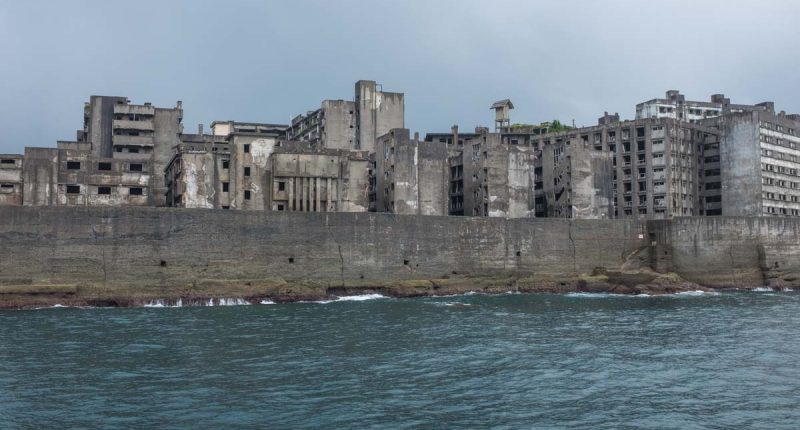

Tour of Sapporo Breweries Chiba Beer Factory
- Guided Tours
Share article
Hashima Island (端島) is an abandoned island and former coal mine located about 15 kilometers from Nagasaki . It is more commonly known as Gunkanjima (軍艦島) or “Battleship Island” because, from a distance, the outline of the island and the buildings bear an uncanny resemblance to a battleship.
The island remained deserted for decades after mining operations ceased in 1974, but in April 2009 Nagasaki City allowed tour boats to land on the island and today it is one of Nagasaki’s most popular tourist destinations. Popular culture has also helped give the island a second lease of life: Google released a Street View of the island which included many of the areas off limits to the public and it received another PR boost when it was used as inspiration for Javier Bardem’s lair in the Bond movie Skyfall (the film includes an aerial shot of the island, but filming took place in a studio reconstruction).
The History of Hashima Island
In 1853 Commodore Matthew Perry sailed his “black ships” into Edo Bay and provided the catalyst for a chain of events that would result in the Meiji Restoration in 1868 and the ending of Japan’s policy of sakoku (“closed country”). Japan had been living in isolation—aside from limited trading with the Dutch in Nagasaki —for the over 200 years.
Japan was suddenly made very aware of its technological and industrial inferiority to the Western powers, and, fearful of the consequences having seen China’s ports carved up and traded, it embarked on one of the most ambitious industrializations ever seen. And at the heart of that industrialization was coal.
Coal was first discovered on the Hashima Island in 1810, but it was only after Mitsubishi Goshi Kaisha (Mitsubishi Group) bought the island in 1890 for ¥100,000 (about $450k in today’s money) that mining operations began in earnest. Mitsubishi undertook major works that included building sea walls and aggressive land reclamation such that the island tripled in size over the course of the next 40 years.
The company also built the first concrete structure in 1916 to house the island’s growing number of workers—a 7-storey apartment block. It was this same year that an Osaka newspaper first reported that the island “looked like a battleship.” Over the next 55 years more buildings were added including a school, hospital, town hall, pachinko parlour, and cinema, and Gunkanjima became more than just a place of work—it was a close community of workers which, in many respects, resembled a large family. Community leaders would make regular rounds of the apartments to check everything was okay at home or help resolve neighbourly issues before they escalated. There were even cases where, upon reaching retirement, workers would choose to remain on the island rather than go back to the mainland (something that was permitted if their son also worked in the mines).
But there is a darker side to Gunkanjima. The conditions for all workers were so hellish that it is difficult today to try imagine what a normal day must have been like. Operating in 12-hour shifts, the miners—boys as young as 14 among them—would take railed trucks 1,000 meters below sea level to the mine. With temperatures around 40°C and sea-water seeping in through the rocks, these workers would lie prostrate and crawl through tunnels only 60 cm in diameter to pick away at the precious coal. Explosions from natural gas leaks were by no means uncommon. And among the workers there were tens of thousands of Koreans and Chinese who lived on the island as forced labour under the careful watch of Mitsubishi Goshi Kaisha (today’s Mitsubishi Group). In the six years from 1939 until 1945 1,162 Japanese, 122 Korean, and 15 Chinese workers are believed to have died, some from drowning when the shafts flooded with seawater.
Between 1891 and 1974 Hashima Island would contribute approximately 16 million tons of coal to Japan’s reserves. But as the oil replaced as the primary source of energy Hashima began to suffer. At its peak in 1960, 5,127 people lived on the island, representing a population density of 83,600 per square kilometer, probably making it the most densely populated urban area the world has ever seen. Even today, Kwun Tong, the most densely populated district of Hong Kong, has a population density of less than 60,000 per square kilometer. But by the mid-1960s that population had dwindled to just over 3,000, and when the mine finally closed on 15 January, 1974, fewer than 2,000 people lived on the island. By 1975 all had left.
In 2006, the Japanese government applied to UNESCO to register Hashima Island as a World Heritage Site. The move was immediately opposed by Korea, incensed that the application made no reference to the forced labour that was an undeniable part of the island’s history. The application was finally approved in 2015 as part of Japan’s Sites of Japan’s Meiji Industrial Revolution: Iron and Steel, Shipbuilding and Coal Mining.
Touring Battleship Island
Many boat and ferry travel companies offer guided tours of Gunkanjima. These tours disembark on the island so that visitors can see and photograph the abandoned and dilapidated buildings close up; however, due to the structural instability of the buildings (some have collapsed completely), visitors must follow a set course around the outskirts and are under no circumstances allowed inside any of the buildings. Below are some other points to note about the tours:
- Departure depends on weather conditions on the day
- Even if the tour boat departs for Hashima Island, the seas need to be relatively calm for the boat to dock safely. Consequently, it may be the case that you will be able to see the island but not complete the ground tour. In this case, tour companies may make a token 10% refund to visitors as compensation. Some visitors have been known to unfairly complain about tours not landing on the island, but passenger safety is the first priority for these companies. See below for the best times to take the tour.
- Guided tours are in Japanese (even if the websites are in English)
There are five tour companies with permission to land on Gunkanjima.
- Gunkanjima Cruise (English/Japanese)
- The Gunkanjima Concierge Company (English/Japanese)
- Gunkanjima Landing & Cruise (English/Japanese)
- Gunkanjima Tour (Japanese)
- Ebisu Cruise (Japanese)
Prices don’t differ all that much. For a “cruising and landing” tour the price is about ¥4,000 per person including the ¥300 landing fee levied by Nagasaki City. Guided tours take approximately 3 hours, including a 1 hour tour of the island itself. All tour companies offer a morning (9-10am) and afternoon (1-3pm) cruise.
As mentioned, visitors are not permitted inside the building for safety reasons, so here’s some footage to give you an idea of what you’re missing.
When is the best time to visit?
Some tour companies usefully provide detailed statistics about departure and landing rates. I imagine most passengers would rather reschedule the cruise than set off but not be able to land on the island. July to October tours that depart but cannot land are around 5-10% mark (closer to 20% on a bad year). During the winter months (November to February) it seems that if the boat departs it will almost definitely be able to land on the island, and during winter the clear skies mean you can get a great shot of the island from the boat.
Information
You may also like, yokohama chinatown, yamate district, hakone sekisho, ueno sakuragi atari.
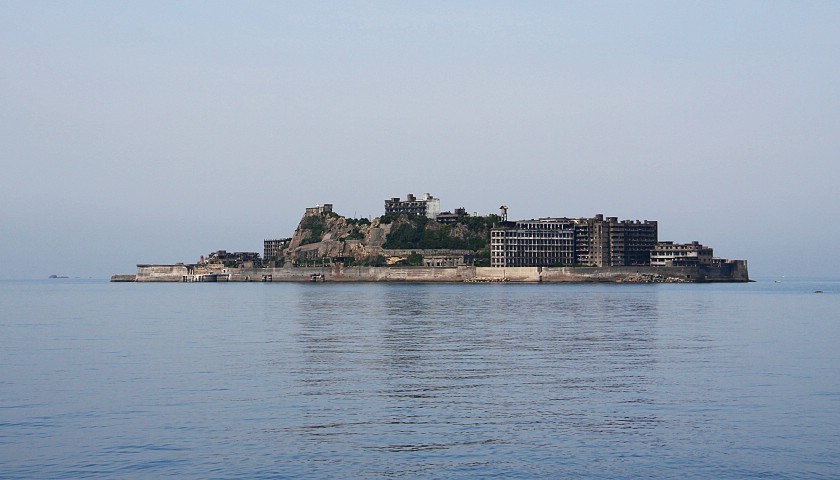
Gunkanjima (�R�͓�) is a small island located about 20 kilometers from Nagasaki Port. Until 1974, the island served as a coal mine, and more than 5000 residents called the 480 meter long, 150 meter wide island home, resulting in the highest population density in history recorded worldwide.
To accommodate so many people in such a small area, every piece of land was built up so that the island came to resemble a massive battleship. In fact, "Gunkanjima" is a nickname that means "battleship island" in Japanese . The island's formal name is Hashima.
Coal was first discovered on Gunkanjima in 1810 by the feudal lord of Saga. Industrial mining began in the late 1800s , and soon after, the island was purchased by the Mitsubishi Corporation. As production increased, the island was expanded, and large residential and industrial buildings and high sea walls were constructed.
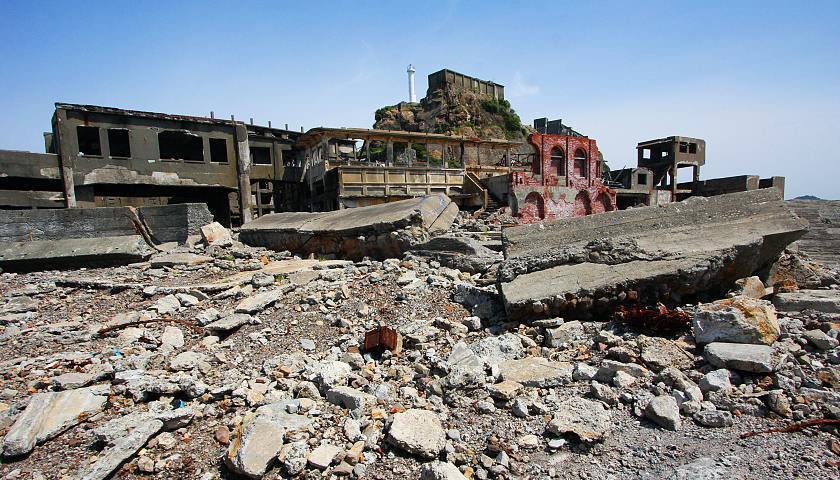
Managers, workers and their families all called the little island home. The residents were able to live out a more or less typical life. Half of the island was devoted to the workings of the mine, the other to residential space, schools, restaurants, shops, a public bath and a hospital.
In April 1974, the mine was closed, and its residents had to leave Gunkanjima, abandoning the island with all its buildings. Over the years since then, direct exposure to typhoons has caused the residences and mining facilities to deteriorate, giving the island an eerie and haunting atmosphere. Due to the danger of collapsing structures, Gunkanjima was closed to the public, and for many years could only be seen from sightseeing cruises that circled the island.
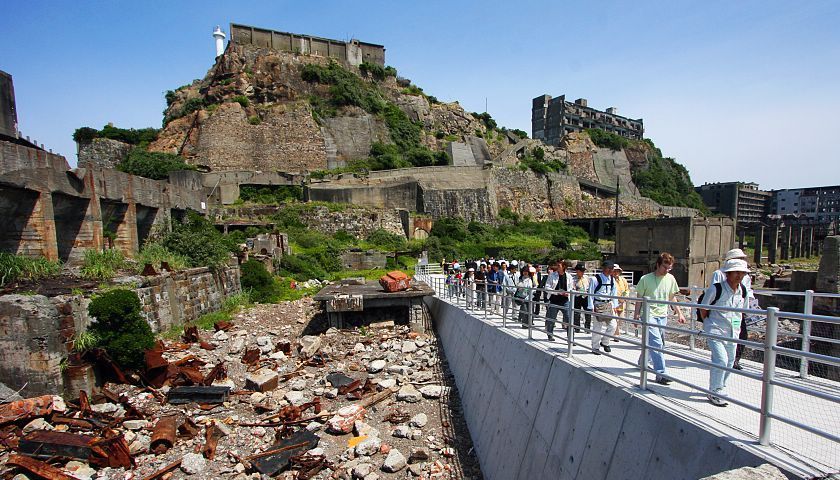
In 2009, a new boat dock made it possible for sightseeing tour boats to land on Gunkanjima. Tour participants are taken to three observation decks in a small part on the southern end of the island and spend about 45 minutes on the island with Japanese speaking tour guides. Tours do not involve getting too close to the buildings because of the risk of collapse.
The boat ride between Nagasaki and Gunkanjima is also enjoyable. Boats take about 50 minutes one way, and pass large Mitsubishi ship building factories and other islands along the way. The ride also allows for nice views of the city of Nagasaki and its port from the water.
For those unable to get to Gunkanjima, an alternative is the Gunkanjima Digital Museum near the Oura Church in Nagasaki . This modern museum boasts an impressive amount of information about the island, including a simulated journey down a working mineshaft and a digital installation that recounts aspects of living through testimonials and photographs. Visitors can also take augmented reality tours of certain areas of the island as they exist today.
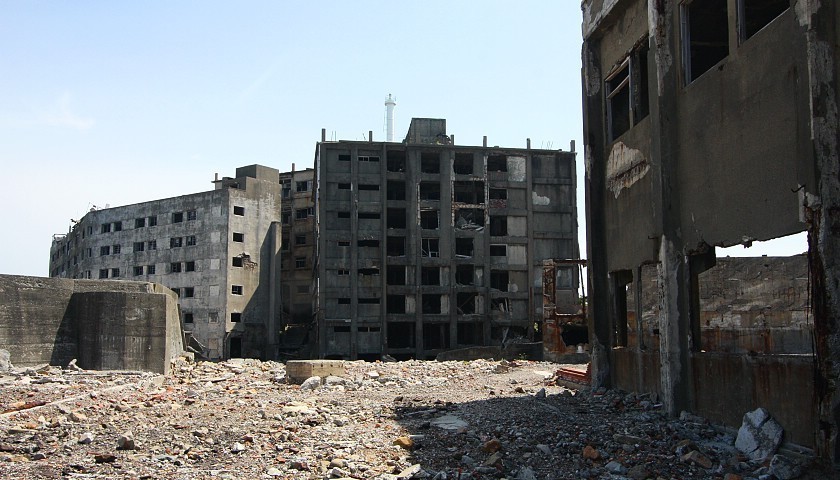
Getting there and around
Tour boats to Gunkanjima are operated by multiple companies and depart from various locations in Nagasaki Port, including the Nagasaki Port Ferry Terminal near the Ohato tram stop (3 minutes by tram line 1 from Nagasaki Station) and the Tokiwa Terminal near the Ourakaikandori tram stop (15 minutes by tram line 1 and 5 from Nagasaki Station).
The Gunkanjima Digital Museum is located a short walk from the Oura Church and the Ouratenshudo tram stop on tram line number 5.
How to get to and around Nagasaki
Hours and Fees
Multiple companies operate boat tours to Gunkanjima . Tours typically take about three hours, including close to an hour spent on the island itself, and cost around 3910-5810 yen per person. Note that in case of bad weather or high waves, landing on the island may not be possible or boats may not operate at all. Advance reservations are recommended especially on weekends and during holidays.
The Gunkanjima Digital Museum is open from 9:00 to 17:00 (entry until 16:30) with a small number of irregular closing days. Admission costs 1800 yen. The museum takes 45-90 minutes to explore and has a moderate level of English, which is contributed to by English headsets that follow the digital installation.
Questions? Ask in our forum .
Links and Resources
Yamasa kaiun, gunkanjima concierge, gunkanjima cruise, gunkanjima digital museum, hotels around nagasaki.
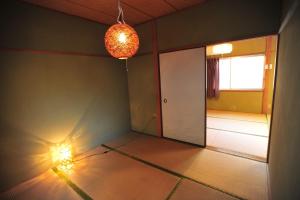
Hashima Island (Gunkanjima): Exploring Japan’s Abandoned Island Fortress
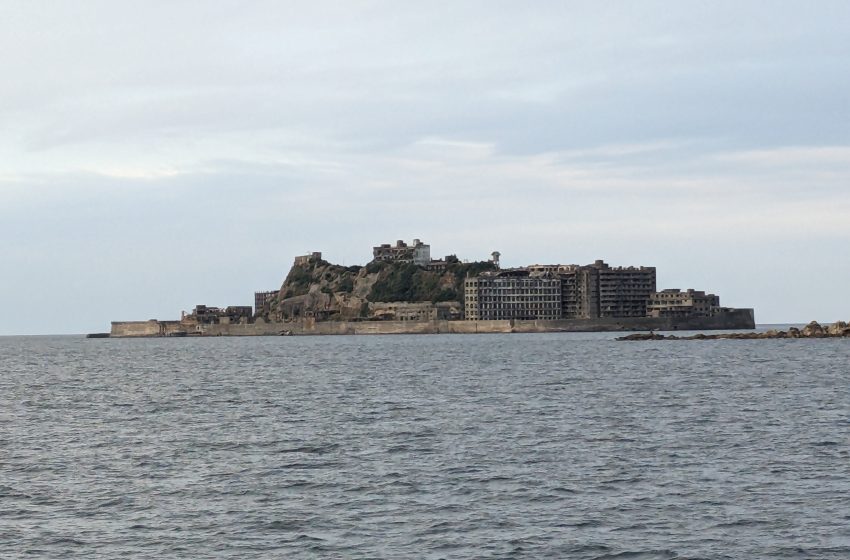
- History Kyushu Travel

Welcome, adventurous spirits and history buffs! Today, we’re setting sail to one of the most intriguing and hauntingly beautiful locations in Japan – Hashima Island, commonly known as Gunkanjima or “Battleship Island.” Once a symbol of industrial prosperity, this deserted island off the coast of Nagasaki offers a glimpse into a forgotten world, where time stands still among the crumbling ruins of a once-thriving community.
The Rise and Fall of Hashima Island
Hashima Island gained its nickname “Gunkanjima” because its silhouette resembles a battleship. The island’s history is as dramatic as its appearance. Discovered to have undersea coal mines in the 1800s, it quickly became a hub of coal production, leading to the construction of Japan’s first large-scale undersea coal mine. At its peak, Gunkanjima was one of the most densely populated places in the world, with workers and their families living in tightly packed apartment blocks.
However, as Japan’s reliance on coal declined and petroleum became the new fuel of choice, the mines eventually closed in the 1970s. The residents left, and the island was abandoned, leaving behind a ghost town surrounded by the sea.
Gunkanjima Today: A UNESCO World Heritage Site
Today, Hashima Island stands as a stark reminder of the rapid industrialization of Japan. In 2015, it was designated as a UNESCO World Heritage Site as part of the “Sites of Japan’s Meiji Industrial Revolution.” The island’s dilapidated concrete buildings, undisturbed and battered by the elements, offer a hauntingly beautiful scene that draws visitors and photographers from around the world.
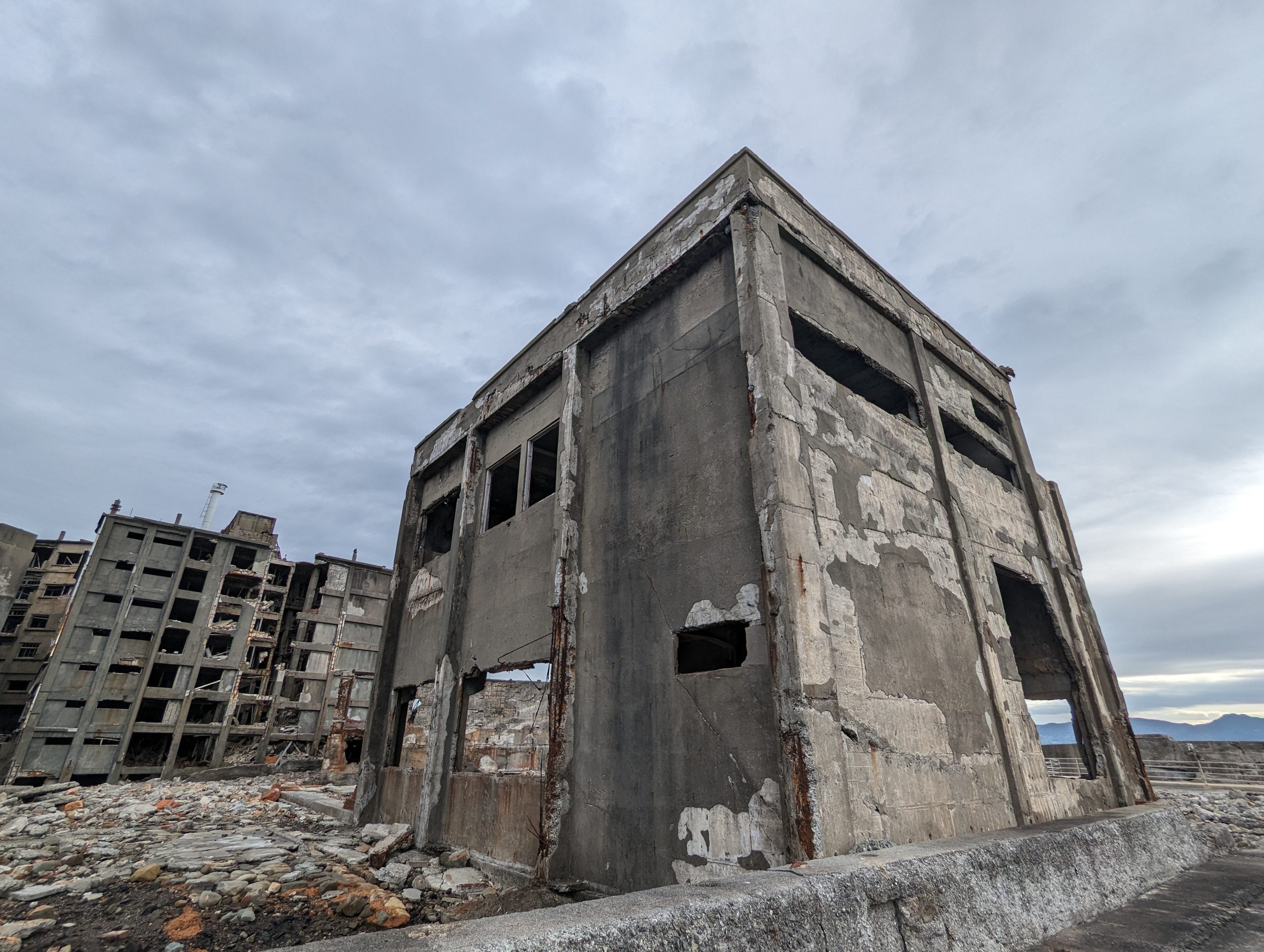
The Photogenic Ruins of Gunkanjima
For those interested in photography, urban exploration, or industrial history, Gunkanjima offers an unparalleled subject. The eerie, abandoned buildings against the backdrop of the sea make for striking images that capture the imagination and evoke the island’s storied past.
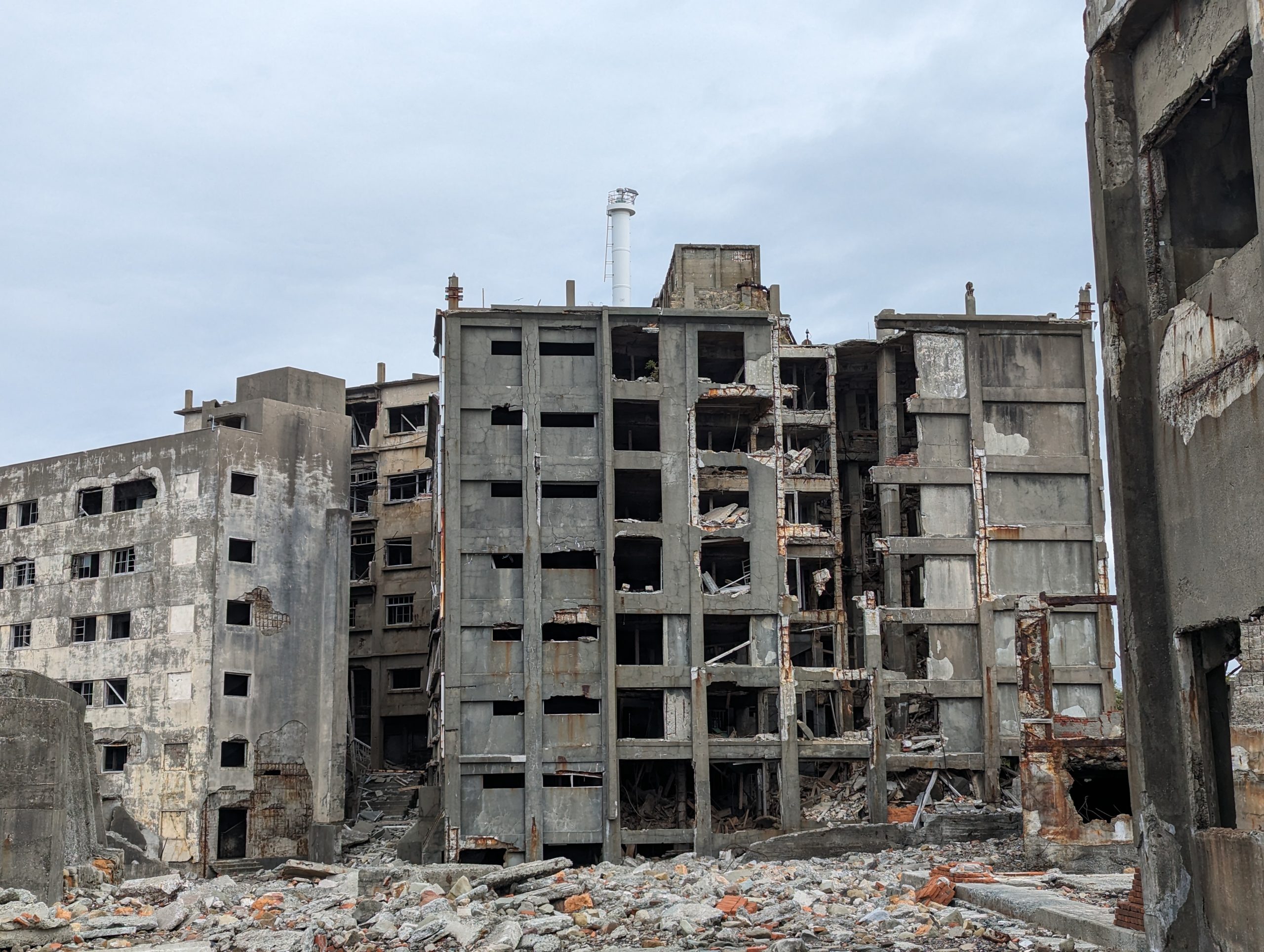
Getting to Hashima Island (Gunkanjima)
To visit the hauntingly beautiful Hashima Island, commonly known as “Gunkanjima” or “Battleship Island,” you’ll embark on a journey from Nagasaki Port. Here’s how you can make your way to this intriguing piece of history:
Boarding the Gunkanjima Landing Tour Boats
The journey to Gunkanjima begins with a 40-minute boat ride from Nagasaki Port. To set foot on the island, you must join one of the official Gunkanjima Landing Tours operated by various companies. These tours are carefully managed to ensure safety and preserve the site’s integrity.
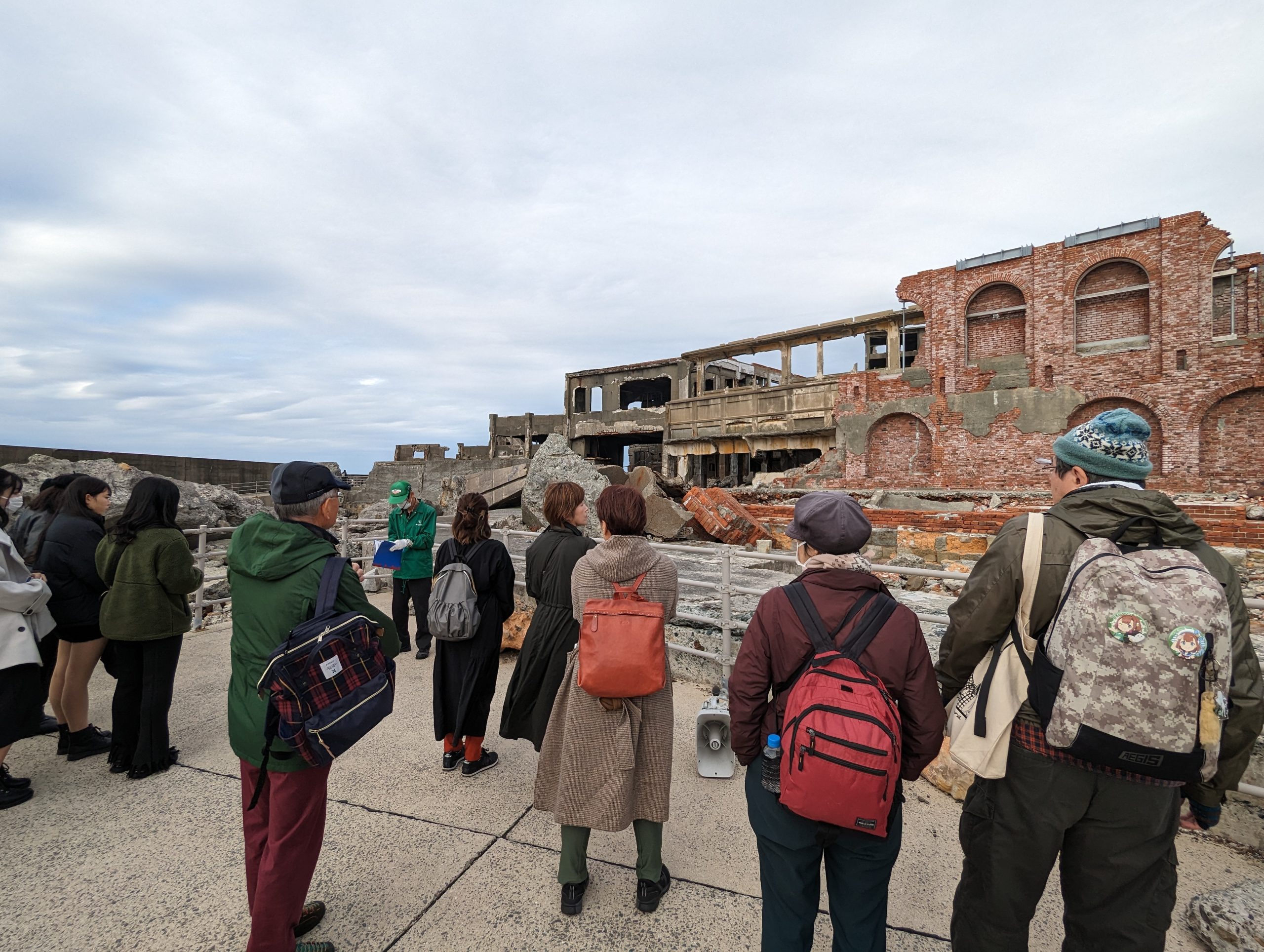
Important Notes:
- Tour Requirement : Access to Gunkanjima is only possible through the official landing tours. Self-guided visits are not permitted due to safety concerns and the delicate nature of the ruins.
- Weather Conditions : Be aware that tours are subject to weather conditions. The sea around Gunkanjima can be rough, and landings may be canceled if conditions are deemed unsafe.
- Reservations and Inquiries : It’s highly recommended to book your tour in advance, as they can fill up quickly, especially during peak tourist seasons. For reservations and specific questions, please contact the tour companies directly.
Tour Companies Operating Gunkanjima Landing Tours
Several companies offer tours to Gunkanjima, each providing unique insights and perspectives on the island’s history. Below is a list of operators with their contact information:
- Phone : 095-822-5002
- Website : Yamasa Kaiun
- Phone : 095-827-2470
- Website : Gunkanjima Cruise
- Phone : 095-818-1105
- Website : Seaman
- Phone : 095-895-9300
- Website : Gunkanjima Concierge
- Phone : 090-8225-8107
- Website : Dai Nana Ebisumaru
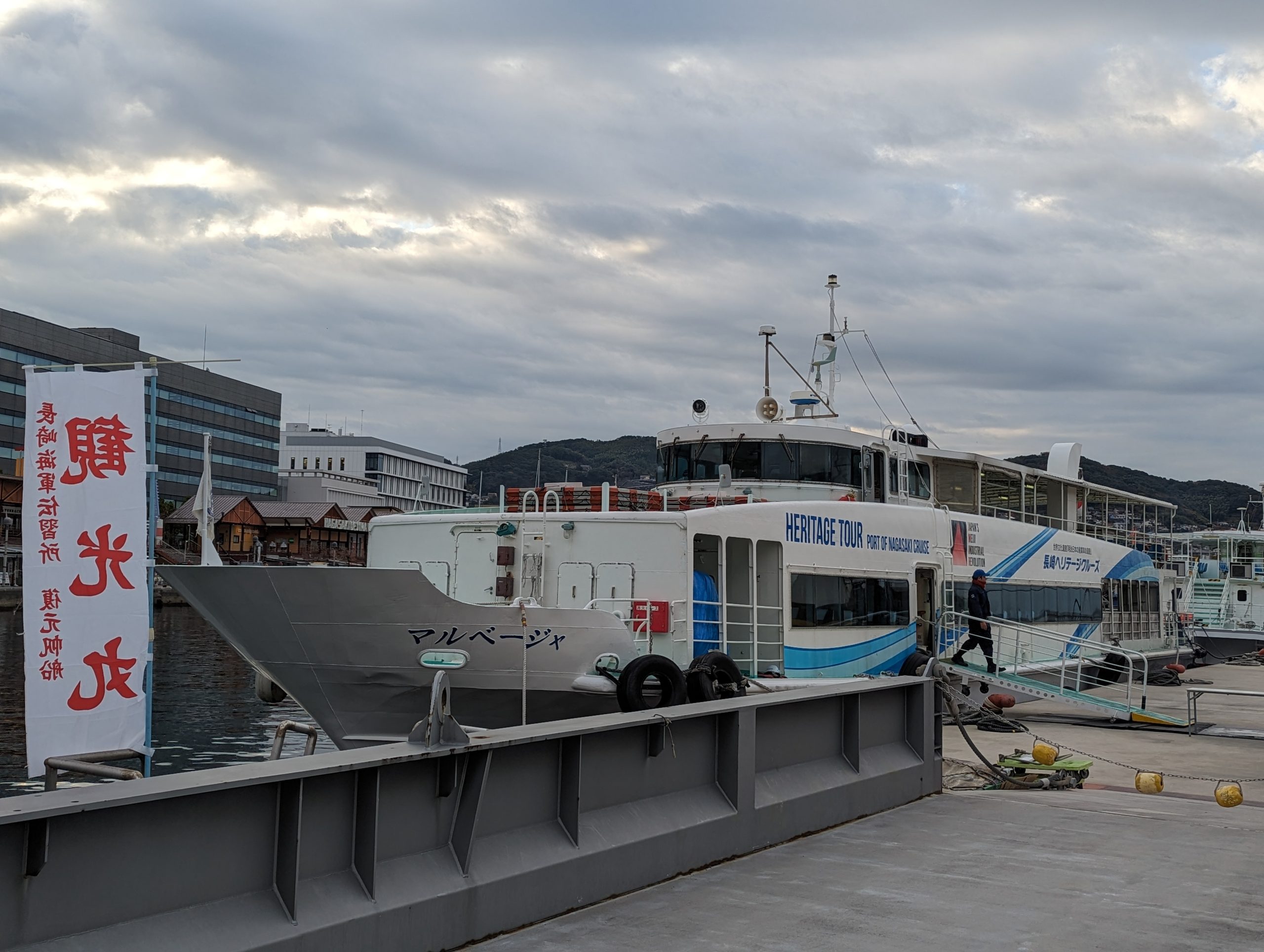
Things to Know Before You Go:
- Safety : The structures on Gunkanjima are unstable and can be dangerous. Stick to the guided paths and follow all safety instructions.
- Weather : The sea can be rough, and tours are subject to weather conditions. It’s best to check the forecast and tour availability in advance.
- Respect : Remember, this site is not just a tourist attraction; it’s a place with a rich and complex history. Treat it with respect.
A trip to Gunkanjima is more than just a sightseeing tour; it’s a journey into a poignant chapter of history. By joining an official landing tour, you’re ensuring a safe and respectful visit to a site that has much to teach about the past and the present. Remember to plan, book ahead, and prepare for an adventure that you’ll never forget.
Explore, learn, and reflect – the enigmatic world of Gunkanjima awaits your arrival.
Conclusion: A Journey to the Edge of Time
Hashima Island is more than just an abandoned place; it’s a physical chronicle of a bygone era, a testament to the lives of those who once called it home, and a symbol of change and resilience. Visiting Gunkanjima is an experience that touches on the complexities of history, the transient nature of progress, and the enduring power of memory.
Embark on this journey to Gunkanjima, and witness firsthand the captivating beauty that arises from the ruins of the past.
Discover, reflect, and remember – Gunkanjima awaits.
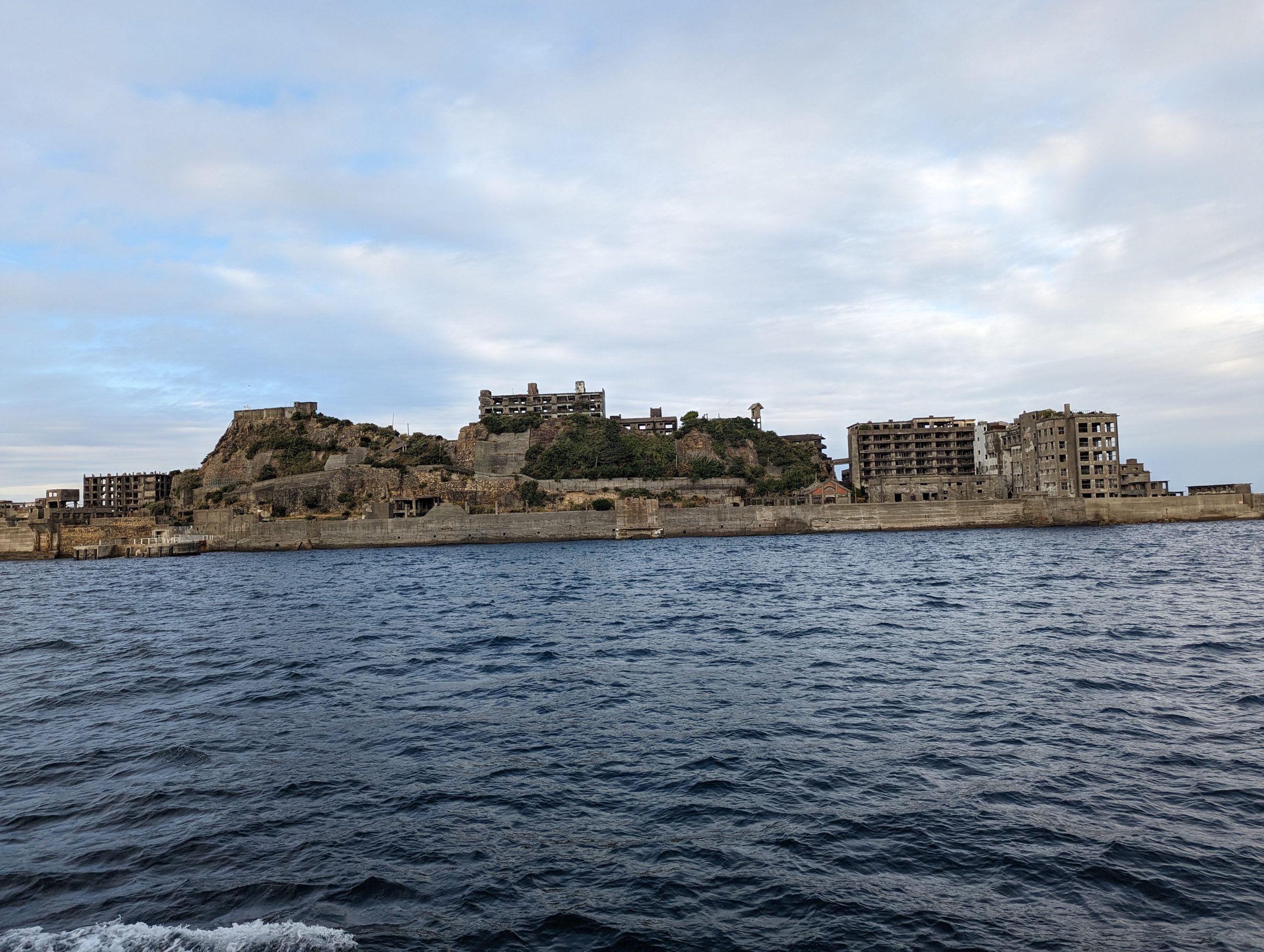
Hello, fellow adventurers! I'm a Tokyo native who's circled the globe, living in the US and Australia before returning to this vibrant city. Exploring Tokyo's streets, conquering mountains, savoring cultures and cuisine—I've done it all. I look forward to sharing Japan's charm with you all.
Related post
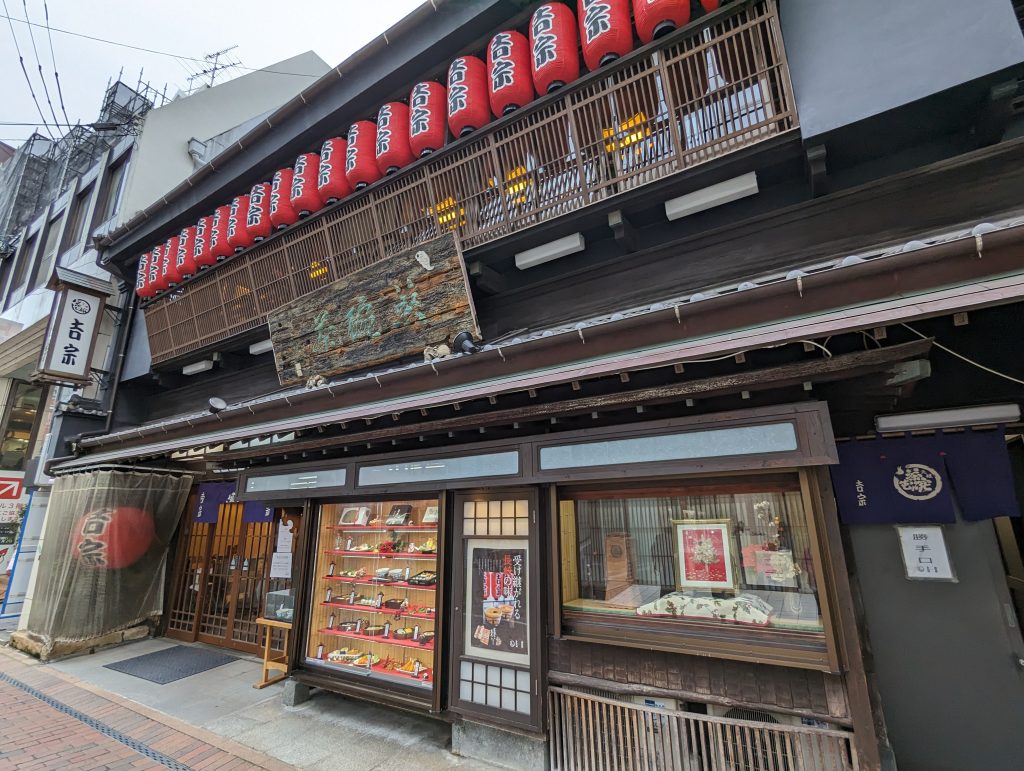
Yossou: Experiencing Nagasaki’s Culinary Tradition
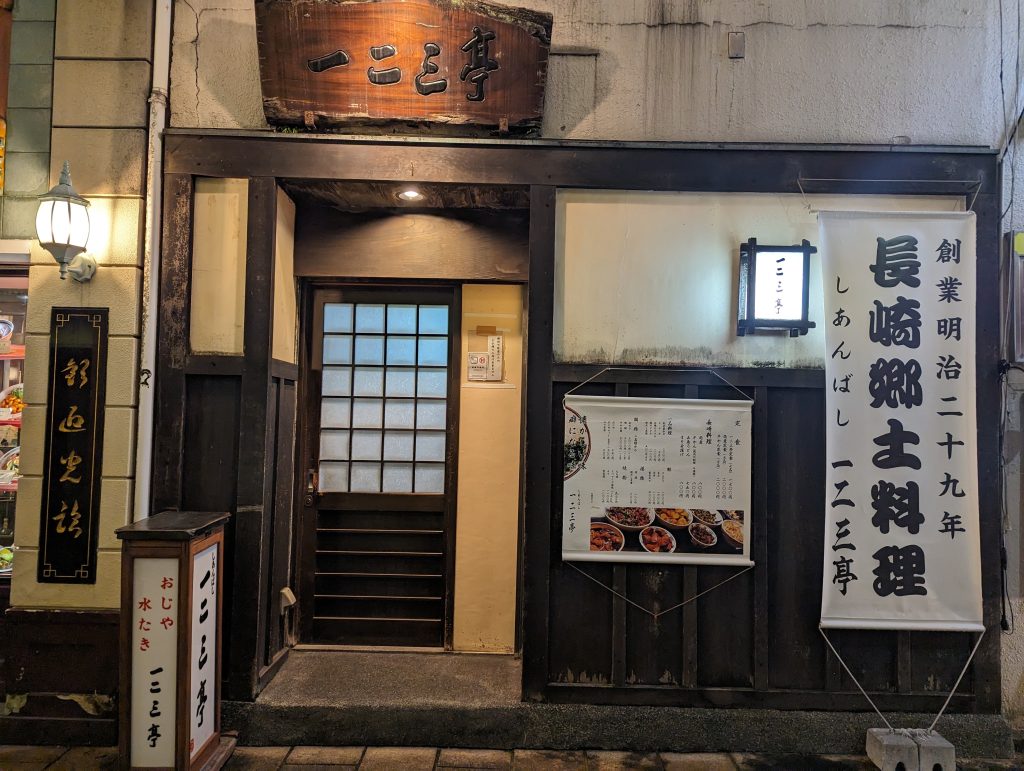
Hifumi Tei: A Culinary Treasure in Nagasaki’s...
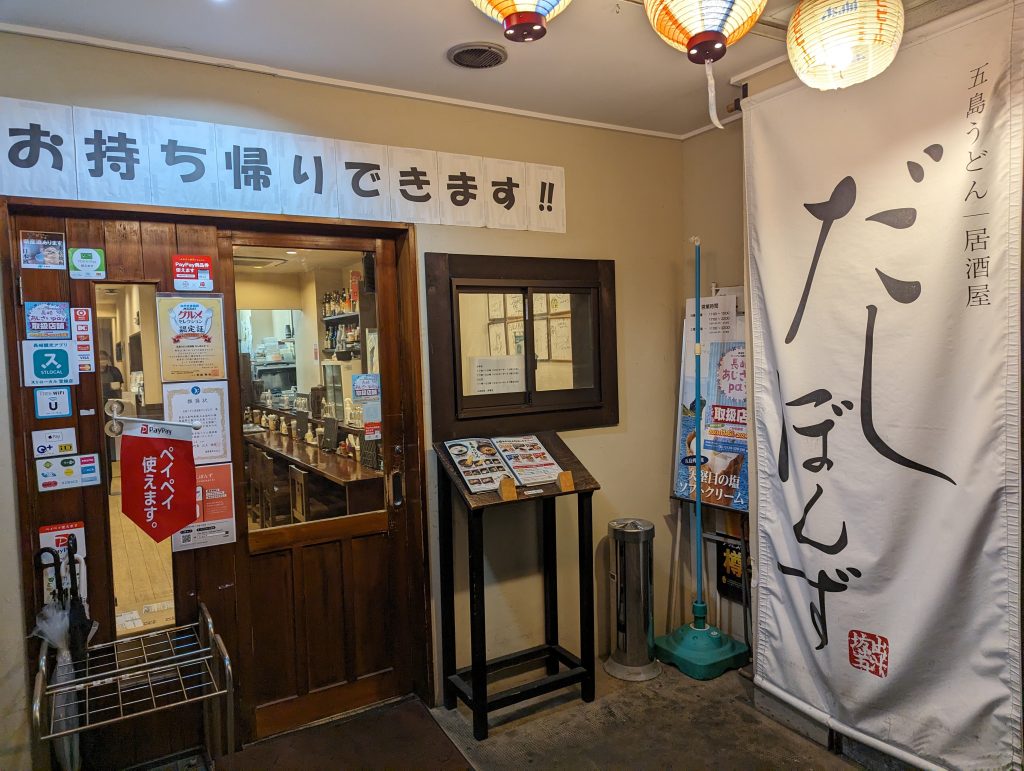
Dashiponzu: Savoring Authentic Goto Udon in Nagasaki
Leave a reply cancel reply.
Your email address will not be published. Required fields are marked *
Save my name, email, and website in this browser for the next time I comment.

Navigating Japan’s Peak Travel Seasons: A Guide for...
Golden week in japan: a time of celebration..., takuan: the crunchy delight of japanese pickled daikon, katsuo no tataki: a taste of japan’s culinary..., goshuin: the sacred artistry of japanese temple stamps, the art of ramen: a culinary exploration of..., japan’s top 3 firework festivals: a spectacular display..., explore the savory world of japanese soba, wp categories.
- Shopping 10
© 2022, JapanPassage - Navigating Your Japan Adventures, All rights reserved.
Hashima Island

Top ways to experience Hashima Island and nearby attractions

Most Recent: Reviews ordered by most recent publish date in descending order.
Detailed Reviews: Reviews ordered by recency and descriptiveness of user-identified themes such as waiting time, length of visit, general tips, and location information.

Also popular with travellers
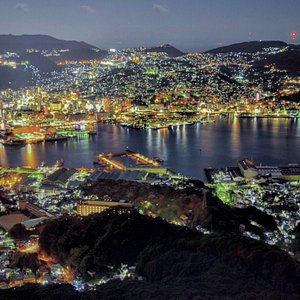
HASHIMA ISLAND: All You Need to Know BEFORE You Go (with Photos)
- (9.57 km) i+Land nagasaki
- (4.21 km) Umino Kenkomura
- (4.21 km) Alega Gunkanjima
- (4.22 km) NOMON Nagasaki
- (6.50 km) Sunset Villa/ Nomozaki Golf Club
- (4.28 km) Monozaki Produce Center
- (4.21 km) Sazanami
- (4.25 km) Cafe Kitchen Kotton
- (4.43 km) Bremari
- (4.67 km) Otorimaru
- (0.03 km) Gunkanjima Concierge
- (0.08 km) Gunkanjima Cruise (Marbella)
- (3.82 km) Nagasaki City Takashima Coal Museum
- (4.71 km) Takahama Beach
- (4.28 km) Suisen no Sato Park
- Haneda Airport
- Okachimachi
- Shimokitazawa
- Kiso Valley
- Nozawa Onsen
- Shinanomachi
- Kumano Kodo
- Japan Journeys Style
- Things to do
- Restaurants
- Hiking and Walking
- Amusement Parks
- Animal Attractions
- Museums and Digital Art
- Parks and Gardens
- Sports and Stadiums
- Temples and Shrines
- Experiences
- Places to stay

- Destinations
- Things To Do
Explore the Decaying ‘Battleship Island’ on a Gunkanjima Cruise
I have a morbid fascination with abandonments. They are symbols of death, bankruptcy, modernisation and economic downturn. Their grimy shadows hide secrets, their decaying decor illuminates history and their silence speaks volumes. Oftentimes, once the decision has been made to walk away, these buildings, amusement parks and towns are frozen in time, defenceless against the unyielding forces of nature, forgotten. But not always. In some cases, like Hashima off the coast of Nagasaki, efforts are made to preserve and even promote the sites as tourist attractions . Those with a penchant for urban exploration should take a Gunkanjima Cruise out of Nagasaki City to witness the crumbling former coal mining island for themselves.
Hashima, a decaying bubble
Hashima, often referred to as Gunkanjima, or Battleship Island, due to its boat-like profile, is a UNESCO World Heritage Site located 15km from Nagasaki ’s city center. Coal mining kicked off here around 1887 and continued for nearly a century until 1974. At its peak, Hashima’s population was over 5,000 people; for such a small island—160m east to west and 480m from north to south—this made it the most densely populated place on Earth.
Though mining was the main industry, residents also had access to schools, shops , a hospital, cinema and swimming pool among many other facilities. It was its own self-contained little world, with easy access to the mainland for anything else they needed. Since the collapse of the coal mining industry and the subsequent abandonment in the 1970s, Gunkanjima has been battered almost beyond recognition by typhoons, giving it a rather spooky appearance. The island was later opened to the public in 2009, but it’s not possible to explore on your own. Luckily, there are a number of tour providers that can ferry you to the island for a guided look.
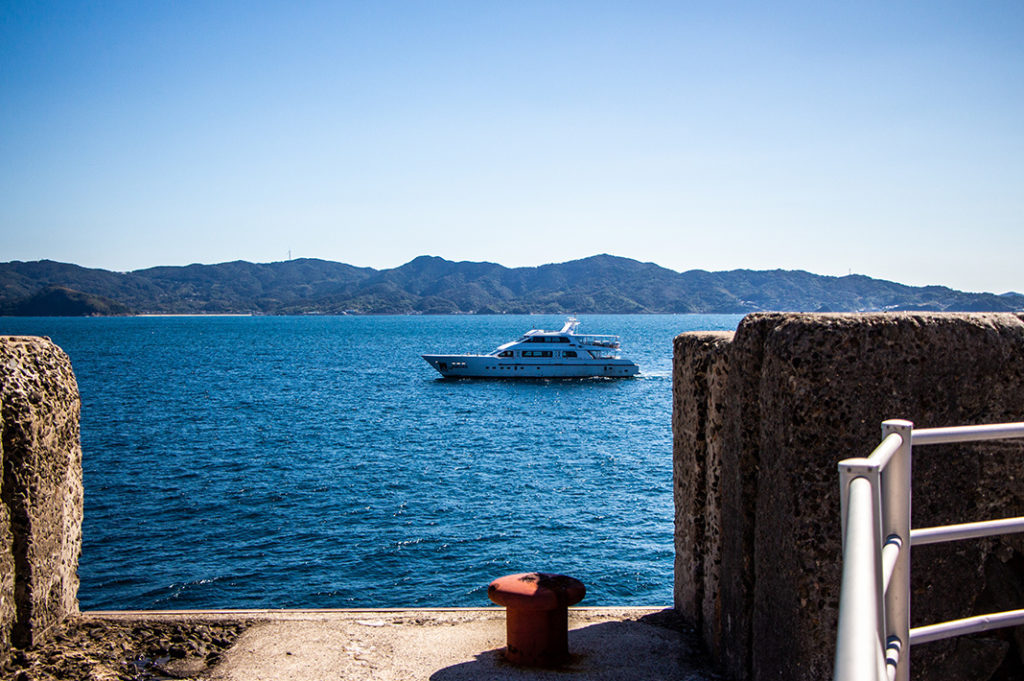
Gunkanjima cruise providers
There are only a handful of companies who are authorised to operate Gunkanjima cruises and tours. In the Motofunamachi area, not far from Nagasaki Station, you’ll find Gunkanjima Cruise Co. and Yamasa-Kaiun . Over at Tokiwa Terminal, near the Oura Church area, are the Seaman Gunkanjima Tour company and Gunkanjima Concierge —the latter of which I chose. Each of the providers offer morning and afternoon cruises, with tickets costing roughly 4,000 yen for adults across the board. Schedules and prices can be found on their respective websites where you can also book directly.
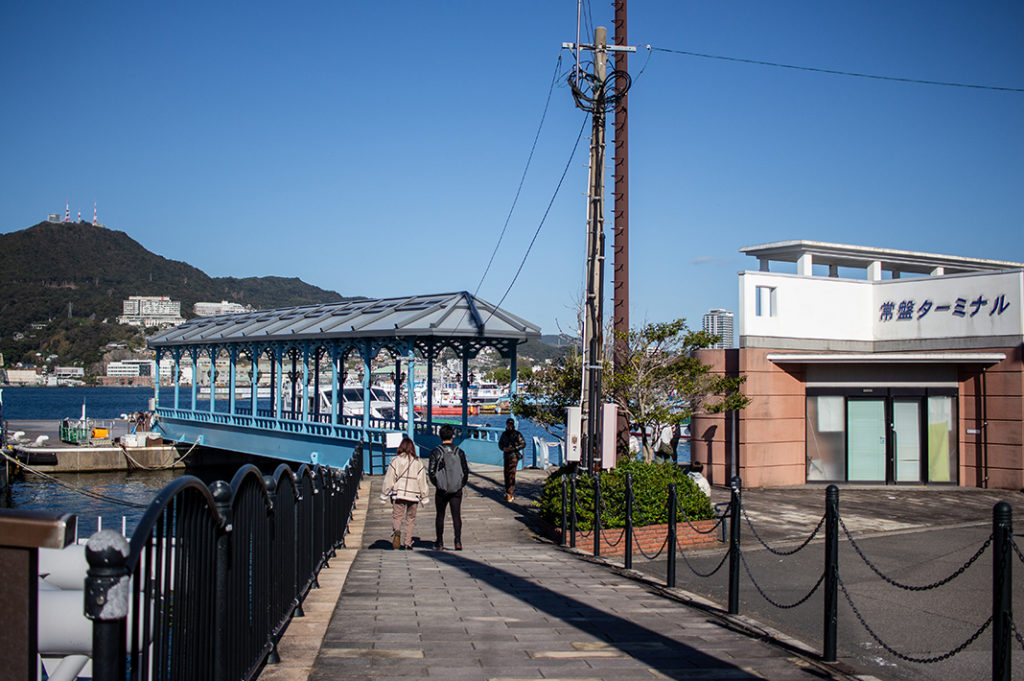
Gunkanjima Concierge
At Gunkanjima Concierge , the regular ticket costs 4,000 plus a 300 yen fee for accessing the island. I went with the next plan up, the ‘Priority’, which costs an extra 900 yen, and gave me half-priced entry to the Gunkanjima Digital Museum as well as priority boarding on the outbound trip. The museum contains three floors of digital displays, movies, images, models and even VR experiences to help visitors understand more about life on Hashima. It is also the check-in point for the cruise and is where you get your numbered sticker for boarding. I wanted to learn as much as possible about Hashima before visiting, so I went early to browse the exhibits with my discounted entry. I will cover this attraction in more detail in my next article. When it was time for the Gunkanjima cruise, I made my way a few blocks over to the Tokiwa Pier.
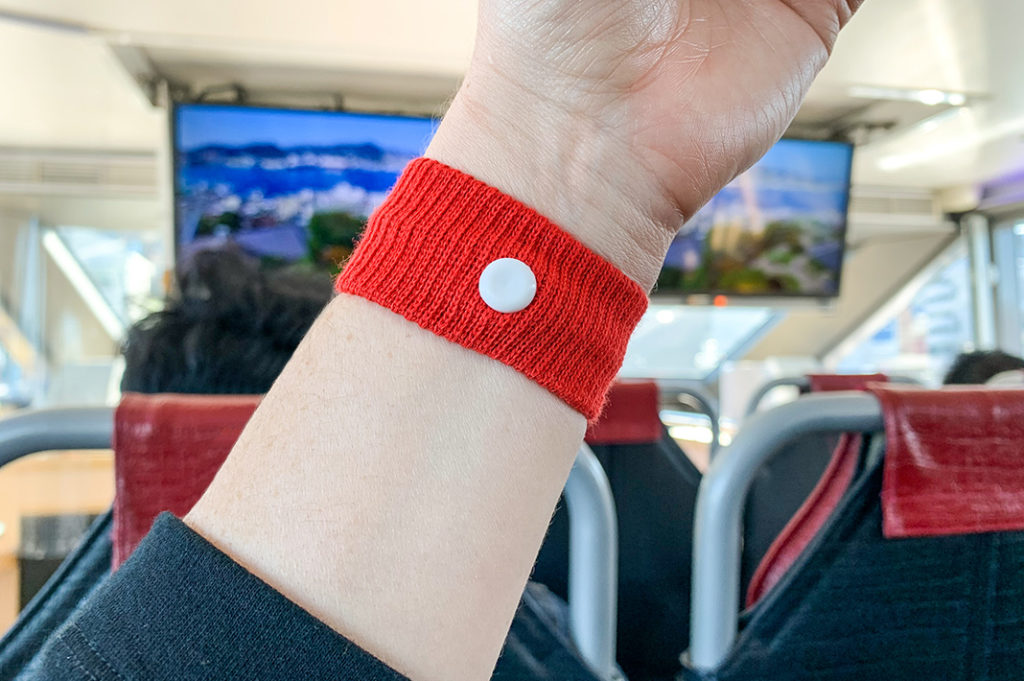
The cruise portion
I arrived to an excited crowd and a dismal forecast. On the day’s information board, the sea conditions were listed as simply a screaming emoji. Just as I had feared, rough seas were ahead. Perhaps seeing my ashen expression, a friendly staff member sidled up and suggested I head inside to purchase the anti-sea-sickness pressure bands; I’ve never spent ¥500 so quickly. By the time I’d gotten my bands in place and was given a folder full of information (in place of the usual English audio guide which was temporarily withheld due to social distancing measures), a long queue had formed beside the ship. This is when the priority boarding privileges came in handy, as I was ushered to the head of the line.
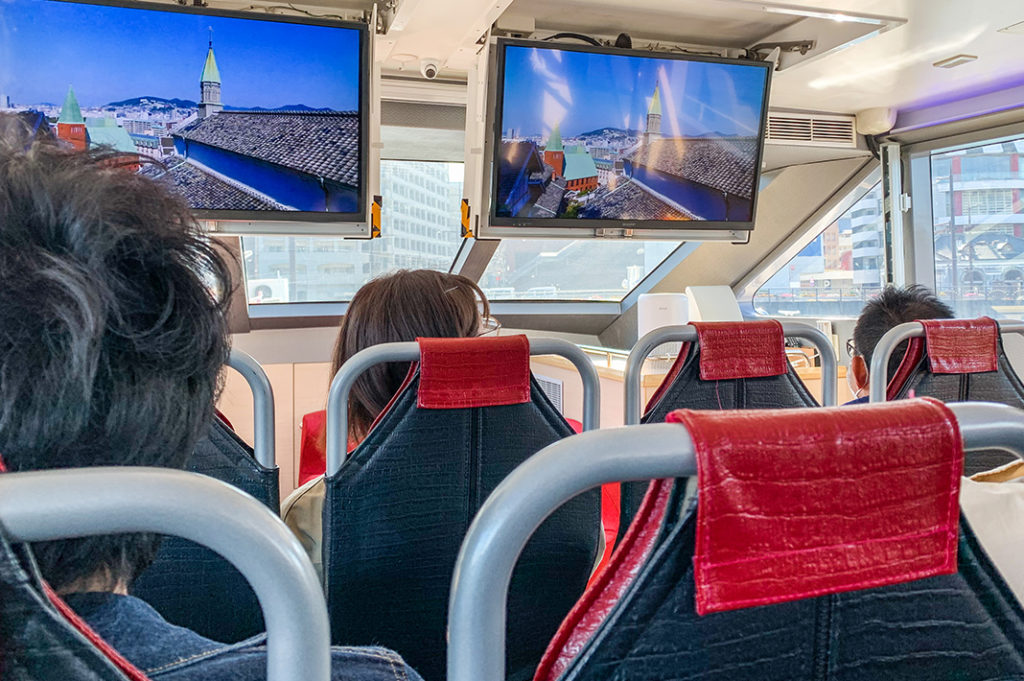
All aboard
The boat is a sit-where-you-like situation. However, the ‘Premium’ ticket (around 8,000 yen) holders had a special area upstairs, as well as VIP access to the front of the boat. I clocked the sick bags, took the boiled lollies from the staff and fastened my pressure bands as we commenced the choppy ride towards Hashima. The seats all faced the front where screens showed images and mid-century footage to accompany the guide’s presentation. He occasionally dipped into English for my sole benefit but the information folder was filled with interesting snippets.
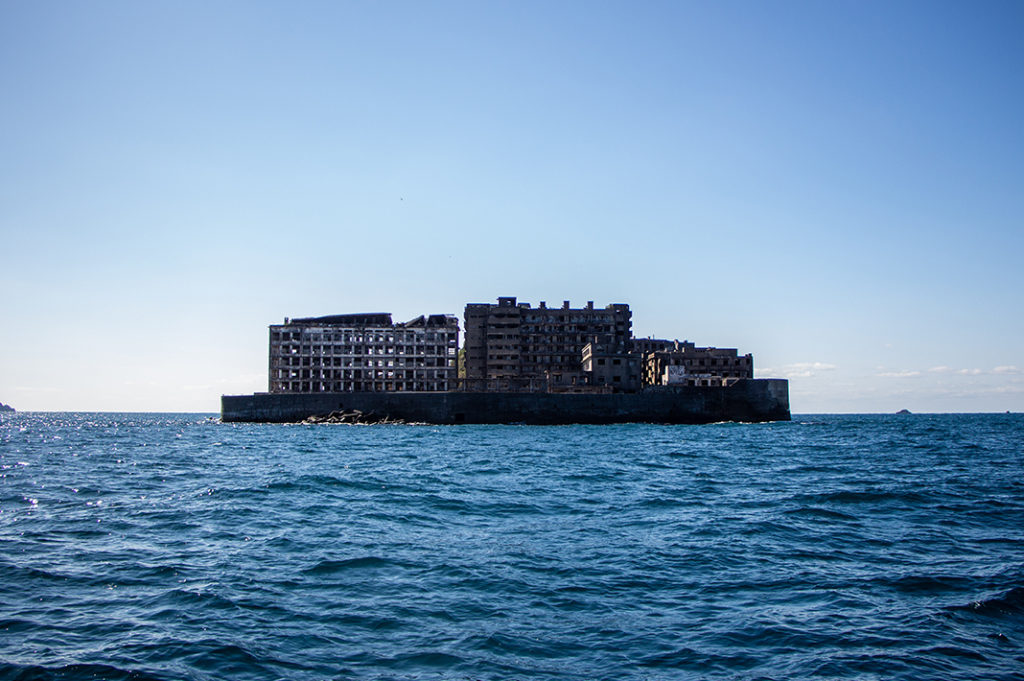
Once Gunkanjima was in sight, the Premium ticket holders went to the front of the ship for photos, while the rest of us went to the windows or out to the rear. The ‘three points of contact’ rule is king, here. It was rough . As we got closer, I could see the sky through the smashed out windows of the deserted high-rises, and the sea birds circling above.

Touring Hashima island
We disembarked and staff led us into the rubble. The roaring sea winds died down, silence descending over us. It’s far too dangerous to walk around the island unattended, so there are three designated viewing zones. Surrounded by concrete, rusted steel and smashed bricks, we made our way through as the guide spoke in Japanese about the history and function of certain buildings. Without the audio guide, I simply took in my eerie surroundings and photographed them.
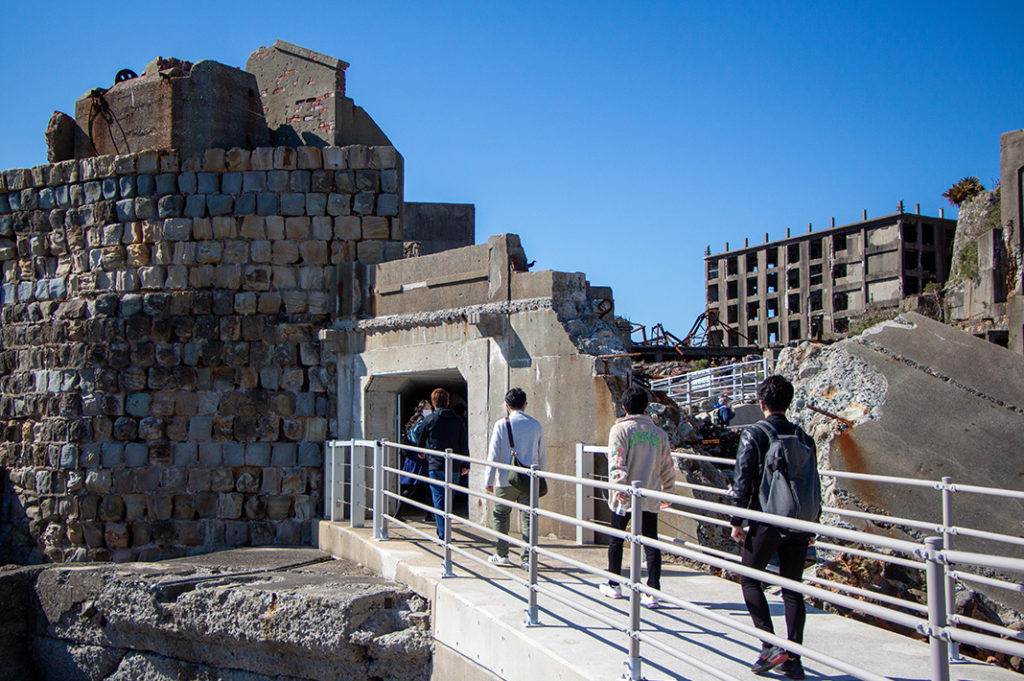
Hashima was home to so many people and many of the former residents have fond memories of their time here. The Digital Museum’s website has a written account from a former resident who returned to the island on a Gunkanjima cruise and said they wanted to scream. Those fond memories replaced by a dystopian warzone. Looking at the drab grey all around, I recalled what I’d read on the boat: that Gunkanjima was jokingly called ‘the island without green.’ At one time, rice paddies were set up on one of the rooftops to teach children about agriculture. Unfortunately, the building wasn’t waterproofed and the rice paddy leaked on the residents below. Oops!
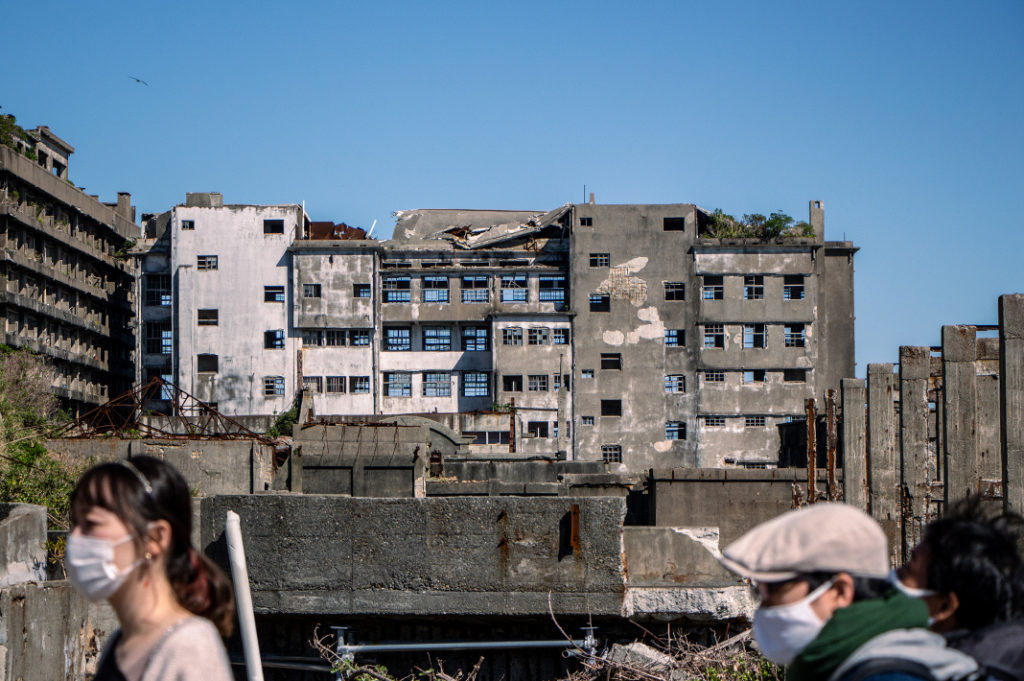
Of course, Hashima also has a sad history. It was, for a time, home to a number of POW labourers who were made to work in the mine. Perhaps this knowledge is what caused me to shiver when I saw the twisted remains of the mining equipment because it wasn’t that cold.
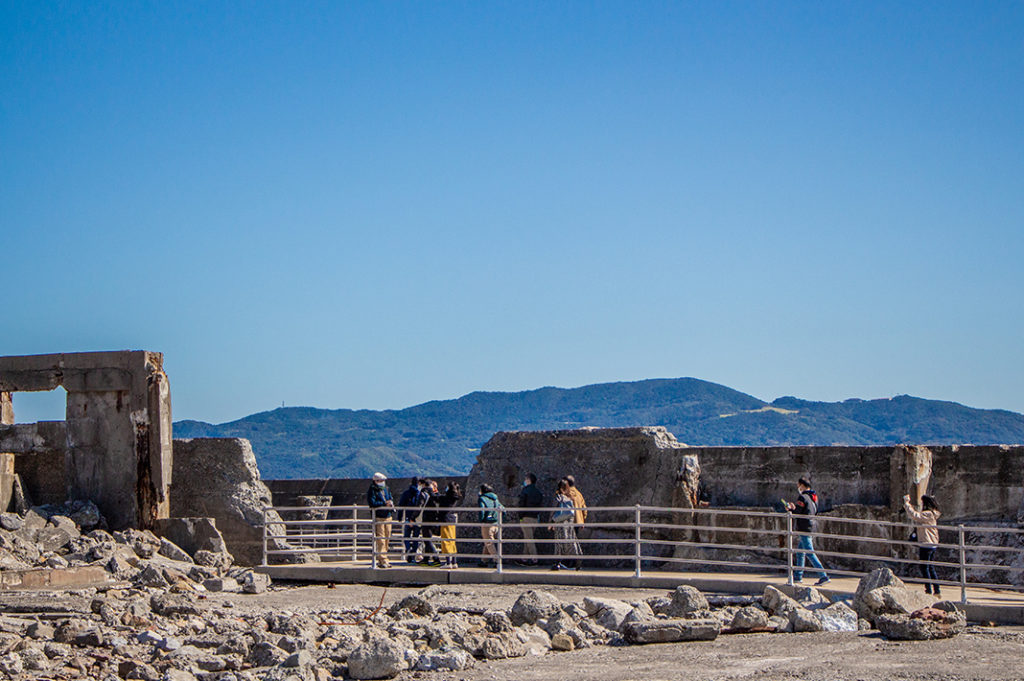
Heading back
The staff herded us back to the boat, as no doubt another tour company was coming our way. I checked to make sure my new favourite thing in the world, the pressure bands, were in place before climbing aboard. On the return journey, I read that Hashima is just one of over 500 abandoned islands in Nagasaki prefecture alone. In fact, Gunkanjima Concierge also offers tours of another island: Ikeshima. Unfortunately, it was closed due to typhoon damage but it’s earmarked for next time.
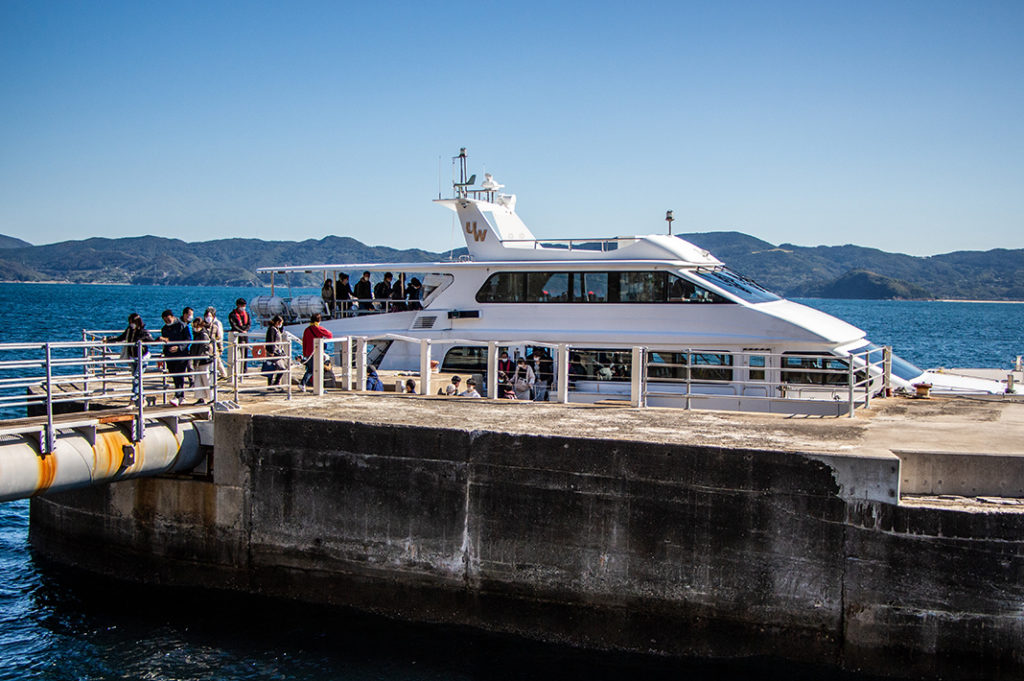
As we sailed back into Nagasaki Bay, our guide pointed out the Mitsubishi shipyard—previous owners of the Hashima mine and Gunkanjima island. It’s fair to say I’ll never look at one of their cars again without thinking of this day.
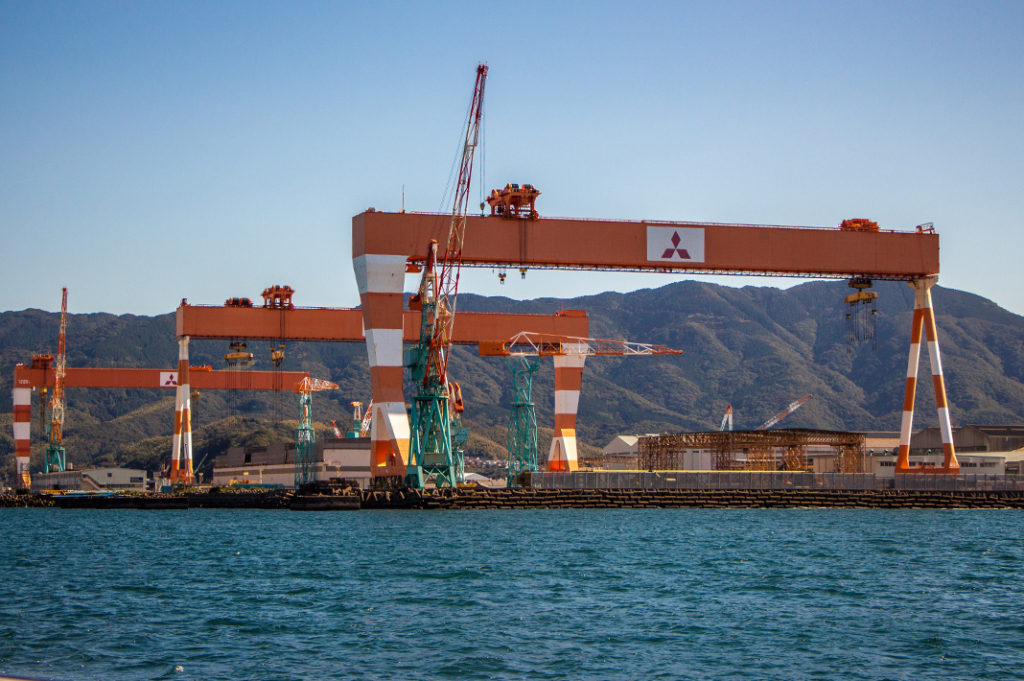
Visiting Hashima was a dream come true. As it is forever deteriorating, there’s no time like the present to visit. For those unable to visit due to poor weather conditions or a tight itinerary, you can always Google it. Amazingly, a person rigged with a 360º camera was sent in so we can experience the ruins using Google street-view. Alternatively, check out the 007 Skyfall movie which has a scene filmed on the island.
Post by Japan Journeys .
RELATED ARTICLES MORE FROM AUTHOR
Ine bay sightseeing boat: birds and boat houses, exploring tokyo’s biggest cave: nippara limestone caves, uga shrine: a power spot island on lake nojiri, most popular, beat the heat with these three kawadoko river dining spots in..., a solid hour of fireworks at the tamagawa fireworks festival, back to the futurism: it’s still the 1990’s in osaka’s den..., kichijoji tour: hammocks, shopping and parks, fukuoka asian art museum: showcasing modern asian art, japan’s rainy season is perfect for hydrangea hunting, rare treasures and chinese architecture at nagasaki confucius shrine, exploring fukue island: a goto island adventure in nagasaki, doza and shianbashi: secret shrines and nagasaki nightlife.

Battleship Island Tour: The Abandoned City of Hashima
Table of Contents
If you haven’t heard of Japan’s Battleship Island, you’ve probably seen it. Battleship Island (AKA Hashima Island Japan / Gunkanjima) was featured as the James Bond island in the film Skyfall.
In this post I’ll cover:
- Battleship Island’s Aliases
- The Hashima Island coal mine
- Abandoned Island Japan: Why Everyone Left
- James Bond Island (where was Skyfall filmed)
- How To Get To Battleship Island
- Battleship Island Tours and other things to do in Nagasaki
Abandoned Island Japan: Hashima Island Gunkanjima
This abandoned Japanese city has several names. The official name is Hashima island, but since it looks like a battleship it picked up the name Battleship Island (or Warship Island). In Japanese, “Gunkanjima” means “Battleship Island.”
Hashima Island, Japan: Originally a coal mining town, but later abandoned when the mines ran dry. Over 40 years of typhoons and rough weather has decayed this city into a beautiful disaster.
If you take a Hashima Island tour, you will only be able to visit a small portion of the outside perimeter of the island. That’s if you’re lucky, considering that sometimes your Hashima island tour won’t be able to disembark if the water is too rough.
Skyfall Island: James Bond visits Hashima Japan
In the 2012 film Skyfall , James bond visits one of the most interesting abandoned places in Japan. You’ll recognize it as the Skyfall abandoned city. You can see several shots from the Skyfall locations in the trailer. An even better shot in this clip from the film .
In the scene from Skyfall, Hashima island is used as the Bond Villain’s hideout in Skyfall. Any type of abandoned city or abandoned island automatically makes for a supercool hideout.
You actually see way more of Hashima Island in the movie Skyfall than from a Hashima Island Tour. Since a lot of the island can crumble at any time, most of it is closed off to tourists for safety reasons.

Origins of Battleship Island
Battleship Island was originally a coal mining town, but later abandoned when the mines ran dry. Over 40 years of typhoons and rough weather has decayed this city into a beautiful disaster.
Life On Hashima, Japan
When Hashima island was thriving as a coal mining town, at it’s peak in 1959 they had up 5,259 people on 16 acres of land. They had many tall building to support the amount of people, but it was still crowded. With that many people in such a small space, it’s historically the most crowded city on Earth.
Even though they didn’t have much land, they still had a soccer field! The people needed an open space to run around. Besides tall apartment buildings, they had all the modern infrastructure: school, town hall, community center, clubhouse, bathhouse, swimming pool, cinema, rooftop gardens and of course a pachinko parlour.
Booking Battleship Island Tours
Hashima Island is 9 miles (15km) away from Nagasaki through choppy waters. It’s a 40-minute ride each way and there were many warning about people getting sea sickness.
If you want to book a tour in advance, there’s only two sites to book Hashima Island Tours for 4300JPY:
- Gunkanjima Concierge
- Klook: Battleship Island Tours
I didn’t book in advance and couldn’t book the tour on the same day online. Not a problem though. There are several tour companies that you can book at the Nagasaki Ferry Terminal for last minute trips!
Getting To The Nagasaki Ferry Terminal
Nagasaki is a pretty small city and you can walk everywhere. If you’re staying anywhere near the city center, you can walk to the Nagasaki ferry terminal.
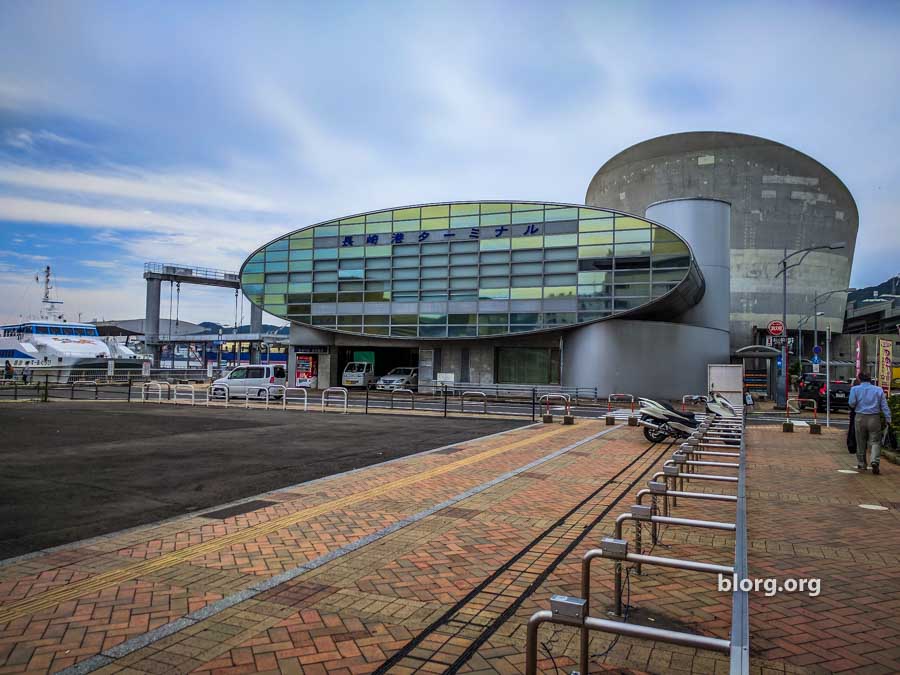
I booked my tour with “Gunkan-Jima Cruise” for 4200 JPY + 300 JPY (entrance ticket). The tour would be in English tour for a total price of 4500JPY. It was a little more than the tour you can book online (4300 JPY), but it was great being able to book last minute.
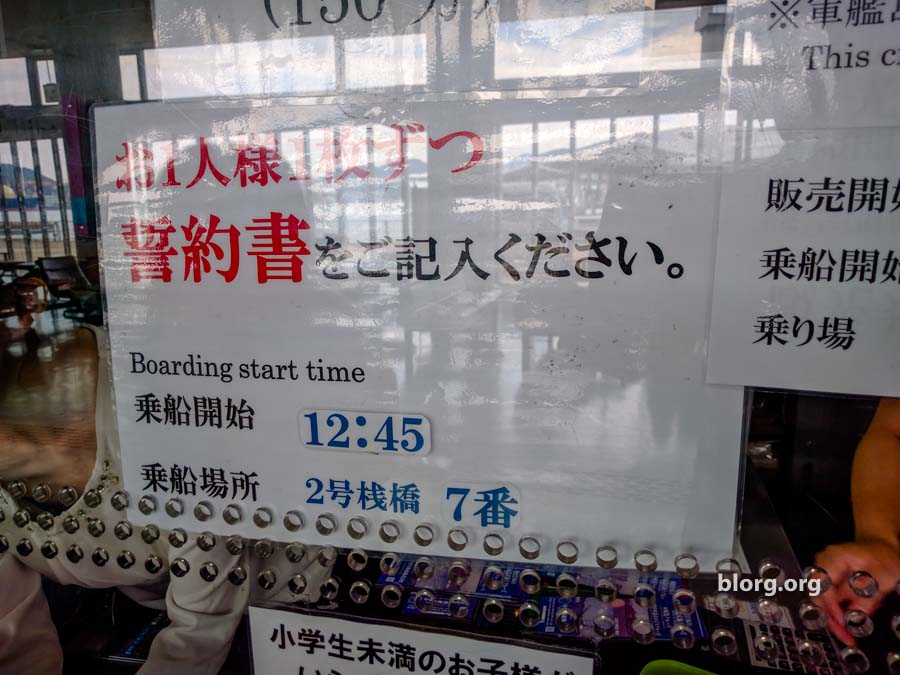
Before making the purchase, I was required to sign a safety waiver since there was some danger involved. That just made the trip a little more mysterious and exciting. The ferry departed at 1pm from port #7.
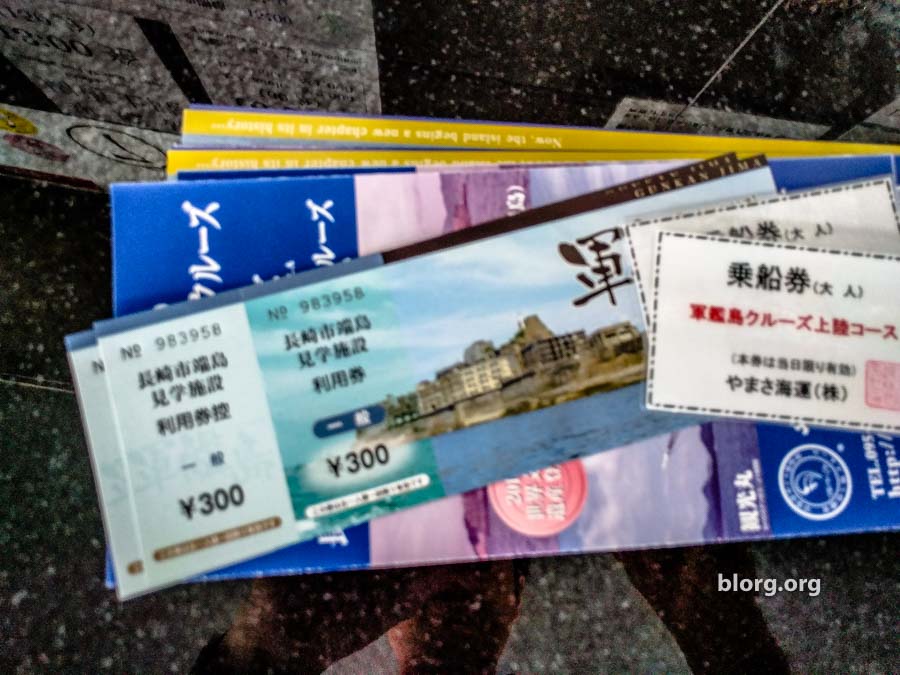
Preventing Seasickness
I get very seasick. Planes, trains and rollercoasters do not give me motion sickness, but being on water does. I’ll never be a pirate. The only way to prevent this issue is to take motion sickness medicine.
Right next to the Nagasaki Ferry Terminal is a large department store (mall). I went into the mall and found the pharmacy area on B1. At this point the ferry was going to depart in 20 minutes so I had to hurry. With my Google Translate app, I looked up “motion sickness medicine” in Japanese and then asked one of the employees.

They redirected me to this very cute Hello Kitty motion sickness medicine so I bought it and headed back to the port. Motion sickness medicine for adults was available, but I went with Hello Kitty.
Ferry Ride to Battleship Island
Boarding the ferry to Hashima island consisted of mostly Japanese tourists. I felt really lucky to have gotten a ticket now since there were so many people.
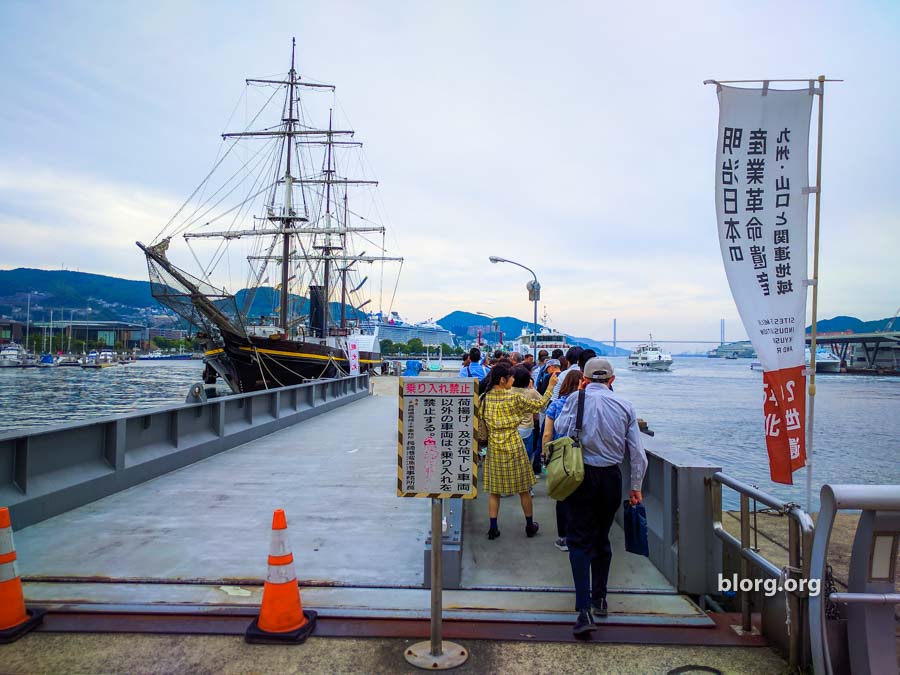
The ferry would take approximately 40 minutes through rough water. It was rough, but I didn’t get seasick. The seats were pretty basic bench style for 4500 JPY. I looked at the tour provided by Klook and the seats looked way nicer for a lower price!
Issue With Booking Tickets In Advance
In cases of bad weather, two things may happen:
- The water becomes too choppy, the ferry won’t be able to dock at Hashima Island. Instead of docking they will just sail in circles around Battleship Island for an hour.
- If the weather is EXTREMELY bad, the ferry won’t depart Nagasaki Ferry Terminal. In this case everyone will get a refund.
Disembarking At Battleship Island
When we arrived at Gunkan-jima they had two groups disembark; the English tour then the Japanese tour.
Only 2 boats can be docked at Hashima Island due to the limited size of the dock. Typically they limit each visit to 1-hour per tour group. That’s all you really need on this Japanese abandoned island.
There aren’t any restrooms on Hashima Island so if you need to use one, you have to go to use the toilet on the ferry. If you need to use the restroom, the ferry will be at the dock so you can go back to use the restroom at any time.
Additionally there aren’t any food vendors or trash cans on Hashima Island.

The area where you can walk around is very limited. There were three sections where the tour stopped to explain things about the island. We weren’t allowed to wander around on our own. Security was very vigilant about watching the tour groups and keeping people in the safe areas. The buildings are very dilapidated and can fall at any given moment.
The island was abandoned 40 years ago and after 40 years of rough weather and typhoons, the island is now in this condition.
Ferry Ride back to Nagasaki
After about an hour of touring Battleship Island, the tour ended and we returned to the ferry. The ferry took a lap around the island so we could get a better feel of what we missed out on.
As we got closer to Nagasaki, the staff walked around trying to sell souvenirs for Gunkanjima. They were selling hats, T-shirts, towels flags and postcards. It’s really hard to sell souvenirs with an island as the mascot.
I passed on making any purchases.
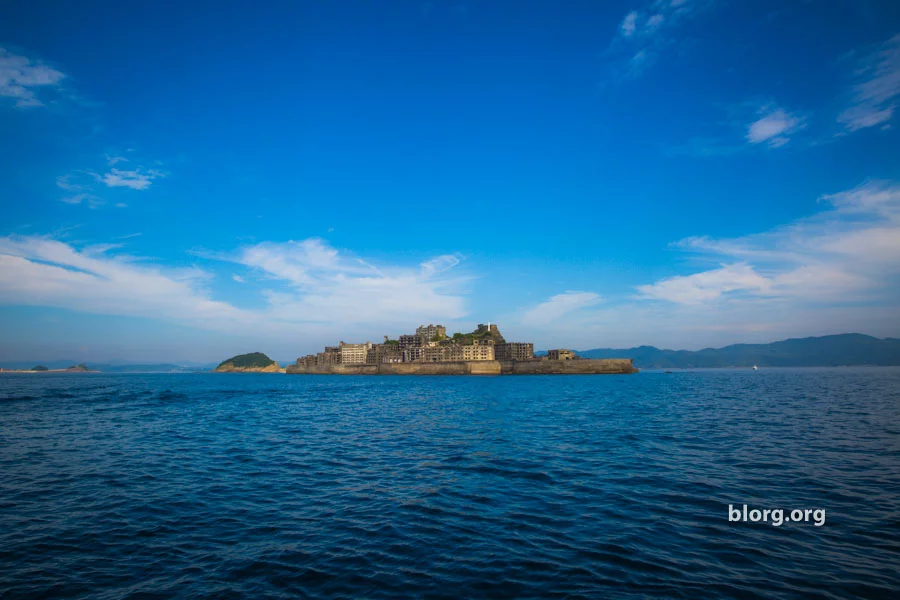
Getting to Hashima depends on good weather! Planning last minute helps and if you’re lucky with clear weather that’s even better!
If you’re not as lucky, the Hashima Island tours offer free refunds if the weather is so bad that they can’t even leave the Nagasaki ferry port.
Your best chance is to plan a flexible schedule and go on the day with the best weather. You don’t really have to buy your tickets in advance since there are multiple ferry companies, but only one company is available to book online (and in English).
Things To Do In Nagasaki
Seeing Hashima Island was beautiful yet sad. I returned to my Nagasaki Capsule Hote l and decided not to continue eating any more horse …at least for now. So If you’re in Nagasaki for a few days you can do the following:
- Take a day trip to the Dutch Amusement Park Huis Ten Bosch
- Eat at Huis Ten Bosch Robot Restaurant
- Visit (but don’t stay) at Henn Na Hotel
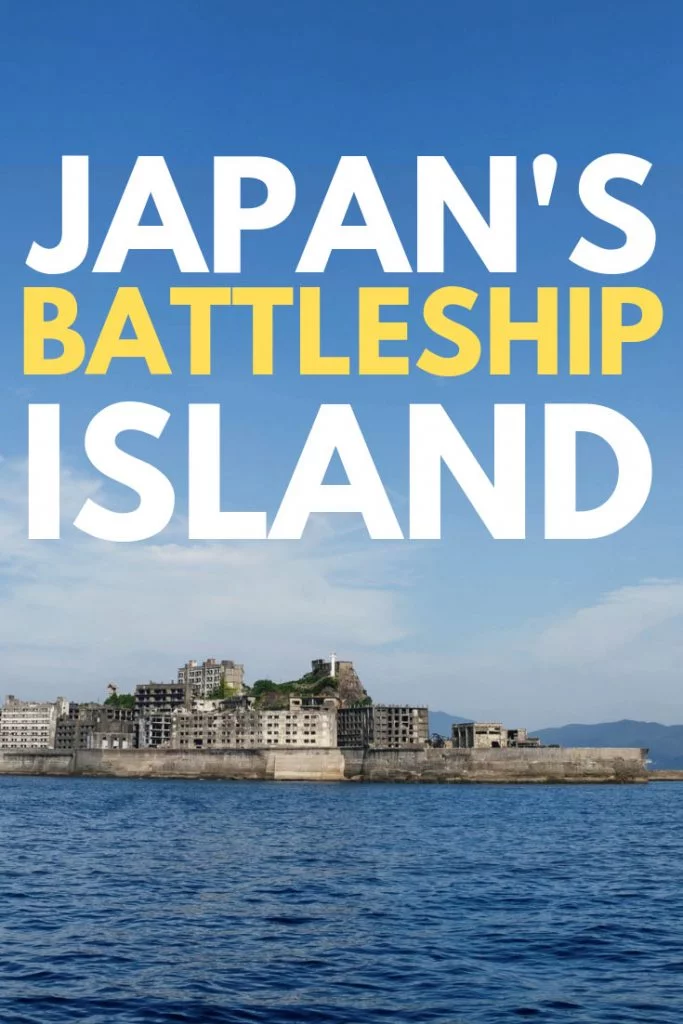
Disclosure: The Klook links are affiliate links were I get a small commission. It’s still as cheap of cheaper than the lowest prices you can find online.
- Privacy Policy
- Media & Industry
- Meetings & Events
- Select Language 简体中文 繁體中文(香港) 繁體中文(臺灣) India (English) Bahasa Indonesia 한국어 ภาษาไทย Tiếng Việt Singapore (English) Philippines (English) Malaysia (English) Australia/New Zealand (English) Français Deutsch Italiano Español United Kingdom (English) Nordic countries(English) Canada (English) Canada (Français) United States (English) Mexico (español) Português العربية Japan(日本語) Global (English)
- India (English)
- Bahasa Indonesia
- Singapore (English)
- Philippines (English)
- Malaysia (English)
- Australia/New Zealand (English)
- United Kingdom (English)
- Nordic countries(English)
- Canada (English)
- Canada (Français)
- United States (English)
- Mexico (español)
- Global (English)
- Fujiyoshida
- Shimonoseki
- Ishigaki Island
- Miyako Island
- Kerama Island
- Tokyo Island
- Koka & Shigaraki
- Hida Takayama
- Ginza, Nihonbashi
- Beppu & Yufuin (Onsen)
- Ginzan Onsen
- Nagasaki Islands

- Kumano Kodo
- Shikoku Karst
- Amami Oshima
- Hachimantai
- Omihachiman
- Aizuwakamatsu

- Diving in Japan
- Skiing in Japan
- Seasonal Flowers in Japan
- Sustainable Outdoors
- Off the Beaten Track in Japan
- Scenic Spots
- World Heritage
- Home Stays & Farm Stays

- Japanese Gardens
- Japanese Crafts
- Temple Stays
- Heritage Stays
- Festivals and Events
- Theater in Japan
- Japanese Tea Ceremony
- Cultural Experiences in Japan
- Culture in Japan

- Local Cuisine Eastern Japan
- Local Cuisine Western Japan
- Local Street Food
- Japan's Local Ekiben
- Japanese Whisky
- Vegetarian and Vegan Guide
- Sushi in Japan Guide
- Japanese Sake Breweries

- Art Museums
- Architecture
- Performing Arts
- Art Festivals
- Japanese Anime and Comics
- Japanese Ceramics
- Local Crafts

- Scenic Night Views
- Natural Wonders
- Theme Parks
- Samurai & Ninja
- Iconic Architecture

- Wellness Travel in Japan
- Japanese Ryokan Guide
- A Guide to Stargazing in Japan
- Relaxation in Japan
- Forest Bathing (Shinrin-yoku)

- Experiences in Japan
- Enjoy my Japan
- National Parks
- Japan's Local Treasures
- Japan Heritage
- Snow Like No Other
- Wonder Around Japan

- Visa Information
- Getting to Japan
- Airport Access
- COVID-19: Practical Information for Traveling to Japan
- Anime Tourism
- Countryside Stays
- Accessible Tourism
- Hokkaido Great Outdoors
- Scenic World Heritage in Tohoku
- Shikoku’s Nature and Traditions
- Southern Kyushu by Rail

- Traveling by Rail
- How to Travel by Train and Bus
- JR Rail Passes
- Scenic Railways
- Renting a Car
- Sustainable Travel in Japan
- Travel Brochures
- Useful Apps
- Online Reservation Sites
- Eco-friendly Accommodation
- Luxury Accommodations
- Traveling With a Disability
- Hands-free Travel
- How to Book a Certified Tour Guide
- Volunteer Guides
- Tourist Information Center

- Japanese Manners
- Spring in Japan
- Summer in Japan
- Autumn in Japan
- Winter in Japan
- Cherry Blossom Forecast
- Autumn Leaves Forecast

- Japan Visitor Hotline
- Travel Insurance in Japan
- Japan Safe Travel Information
- Accessibility in Japan
- Vegetarian Guide
- Muslim Travelers
- Safety Tips

- JAPAN Monthly Web Magazine
- Arts & Cultures
- Nature & Outdoor
- Festivals & Events
- Insider Blog
- Things to do
- Local Guides
- Food & drink
- Traditional
- Hokuriku Shinetsu

My Favorites
${v.desc | trunc(25)}
Planning a Trip to Japan?
Share your travel photos with us by hashtagging your images with #visitjapanjp
- Nagasaki City
- Hashima (Gunkanjima)
Hashima (Gunkanjima) 端島(軍艦島)
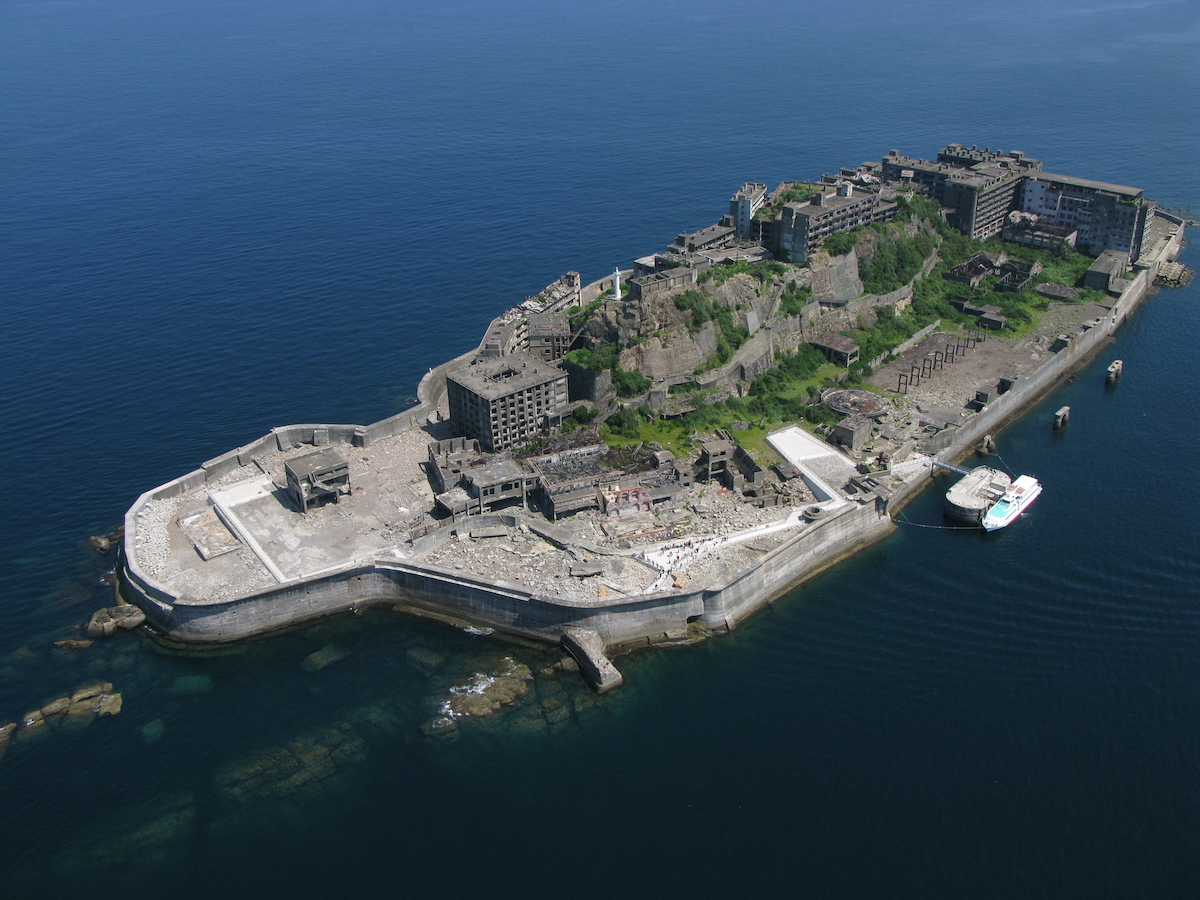
Nagasaki-shi, Nagasaki-ken
- View on Google Maps
- Get Transit Info
A former coal mine in the middle of the sea
- Up-close and personal tours of an abandoned coal mine
- Viewing Gunkanjima from the mainland
How to Get There
To reach Gunkanjima, you must join one of the organized tours that run several times a day. The tours leave from different locations in Nagasaki Port and vary in foreign language availability, age, health restrictions and other options.
Journeys take roughly 30 minutes one-way. Tours may be canceled during times of severe weather or other unfavorable conditions. Advance reservations are highly recommended for weekends and during holidays.
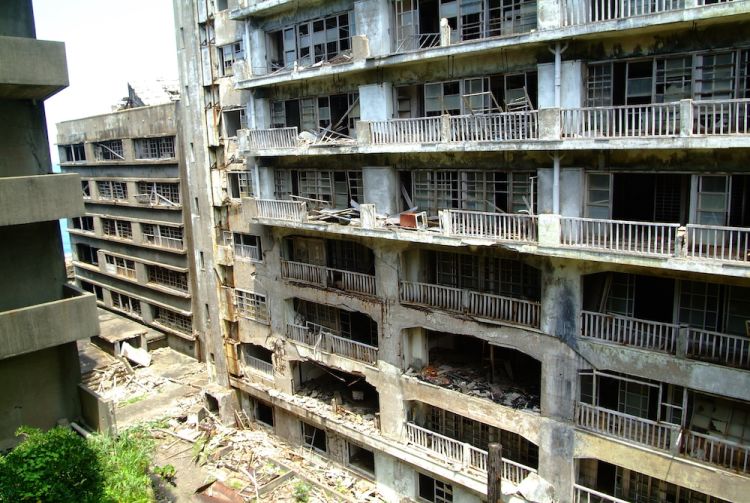
Quick Facts
Gunkanjima is known as an uninhabited island of ruins
The island is a mere 480 meters long and 160 meters wide
Gunkanjima once boasted a hospital, two schools, shops and even a temple and shrine
A symbol of industrial development
A reverse rags-to-riches tale of Japan's modernization in the years leading up to the second world war, Gunkanjima offers a truly unique glimpse into Japan's history. Developed by Mitsubishi and a hub of national coal mining, Gunkanjima's population reached an astonishing 5,300 people (approximately) in its heyday. Yet the island was quickly abandoned in around 1974 when energy needs changed, and the coal mines were closed.
For years the island was left to the elements, a grim symbol of Japan's rapid industrialization.
Dawning of a new era
Opening to tourists in 2009, Gunkanjima spawned an interest in abandoned ruins tourism and was later named a UNESCO world heritage site in 2015. Observing the weather-beaten relics and decaying, dilapidated buildings up close, it's hard to imagine this island was once home to a thriving and vibrant community.
Should you decide not to take a tour of the island, you can view Gunkanjima from Nagasaki's most southern tip when skies are clear. Peer closely, and you may even see the deserted buildings and watch the light filter through the crumbling windows.
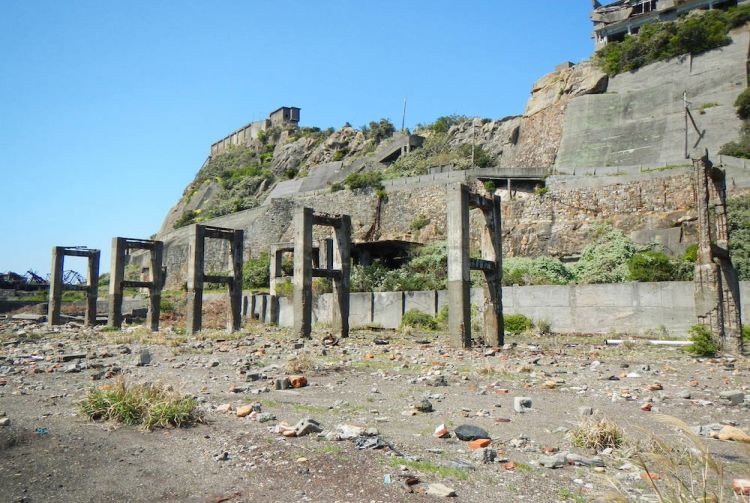
Things to bear in mind
You cannot visit Gunkanjima alone. Due to the structural instability of the island, it is mandatory that all visitors travel in tour groups.
Tours may be canceled due to bad weather. It is best not to plan a trip during typhoon season, rainy season or during the winter months.
You may be denied access due to health issues.
Some tours are not wheelchair accessible. Check with individual tour operators for specific terms and conditions.
You must sign a safety contract to participate in the tours.
* The information on this page may be subject to change due to COVID-19.
- Historical Site
Recommended for You
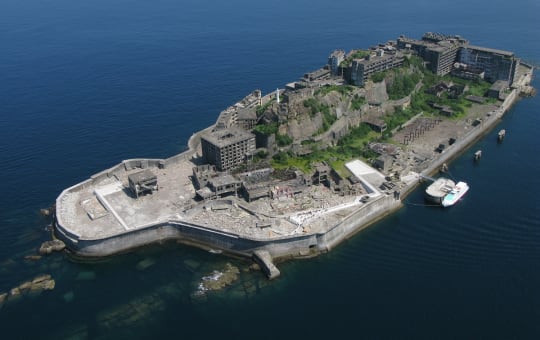
Please Choose Your Language
Browse the JNTO site in one of multiple languages
You are using an outdated browser. Please upgrade your browser to improve your experience.
Gunkanjima (Hashima Island)
The inspiration behind the villain’s hideout in the 2012 Bond film Skyfall, Gunkanjima is an eerie time capsule of Japan’s industrial age.
Some places have ghost towns. Nagasaki has a ghost island—the uninhabited Hashima Island.
It’s referred to by locals as Gunkanjima, or Battleship Island, for its similar appearance to a warship when seen from a distance. Since 2009, tours have been running to the deserted mining island, undisturbed since residents abandoned their homes leaving everything from shoes to electronics to lesson-filled blackboards.
Battleship Island

The island is a reminder of its dark history as a site of forced labor prior to and during the Second World War.
Walking around the crumbling grocery stores and peeking into children’s bedrooms covered with rust and weeds, it’s an eerie glimpse of the imprint of human life on our environment. Begun as a coal mining operation in 1887, the Mitsubishi Company purchased Hashima Island in 1890. Mitsubishi enhanced the island’s mining facilities while increasing its landmass to 16 acres. It then built concrete, high-storied apartment complexes to house its employees and their families, as well as an outer sea wall. At its peak in 1959, Gunkanjima was home to 5,259 people, making it at one time the most densely populated place ever recorded.
By 1974 the mines under Gunkanjima had dried up and Mitsubishi announced it was ending operations. Residents began departing in haste to seek new jobs. Within a few months, the island was completely deserted.

Tourists wishing to get a closer look at the island can easily book a day trip.
The early 2000s saw a renewed interest in Gunkanjima, with a number of different companies in Nagasaki vying to offer tours. It’s the only way to access the island and the whole operation is tightly controlled – just three ferry companies are permitted to run tours – with visitors limited to a walking path that makes up part of the island’s perimeter due to safety concerns. Tours take approximately three hours and are offered in morning and afternoon sessions. Typical programs include ferry rides to and from Nagasaki port to the island and one hour walking on land.
In July 2015, Gunkanjima became a UNESCO World Heritage site . This was despite complaints made by South Korea, later withdrawn, regarding Mitsubishi’s use of Koreans and Chinese for hard labor on the island during World War II. Tour guides are normally reluctant to address this issue so it’s best not to push it. You can (and should) find out more about the history of Gunkanjima online.
Things To Know
As much as you might want to adventure through the abandoned island at your own pace, travelers must be a part of a tour group to visit Gunkanjima. Reservations are available online. Tour companies require guests sign safety waivers and wear hard hats while on the island.

Tour Prices
Ferry tours from Nagasaki range from ¥3,600 to ¥4,200 for adults, with discounts available for groups of 15 members or more. In addition to ferry fees, visitors must also pay a ¥300 landing fee (¥150 for children). This fee is charged by Nagasaki City and goes towards assisting in Gunkanjima’s preservation. It should be noted tours are subject to last minute cancellations if weather and wave conditions prove hazardous. Tour groups may give partial refunds or offer alternatives.
How To Get There
Takashimamachi, Nagasaki, Nagasaki Prefecture 851-1315, Japan
Gunkanjima Concierge Co. Fee: Adults ¥4,000 / Students (Junior and Senior High School) ¥3,300 / Children ¥2000 Departure Area: Tokiwa Pier, Nagasaki Port; Ioujima Pier, Ioujima Port
Gunkanjima Cruise Co., Ltd. Fee: Adults ¥3,600 / Children (~12) ¥1,800 Departure Area: Motohuna Pier, Nagasaki Port
Yamasa Shipping Co., Ltd. Fee: Adults ¥4,200 / Children ¥2,100 Departure Area: Ohato Pier #2, Nagasaki Port
Where To Stay
- 1-27 Iojimamachi, Nagasaki-shi, Nagasaki, 851-1201 Japan
- ¥15,000 - ¥30,000
- 1-3277-7 Iojimamachi, Nagasaki-shi, Nagasaki, 851-1201 Japan
- ¥24,310 - ¥52,580
- 4.31/5 (1,923 reviews)
Topics: Islands , Nagasaki , Offbeat
Explore Nearby

- Destination Nagasaki
- Speciality Museums
Nagasaki Peace Park
Serving as a sobering reminder of the loss of life that occurred, the Nagasaki Peace Park is also an artistic symbol of the enduring struggle for peace.

- Speciality Cities
A vibrant and thriving port city.

- Destination Kyoto
The best place to discover Japan's rich and unique heritage.
How to Japan
Guide to using the jr pass, 10 foods to try in japan (that aren’t sushi or ramen).
- ©2024 GPlusMedia Inc.
- Terms of Use
- Privacy Policy
- Tokyo Cheapo (繁體中文)

Adventure out to Gunkanjima (Battleship Island)
Give yourself the James Bond experience with a visit to the movie-famous Battleship Island, just off the coast of Nagasaki, on a Gunkanjima tour. Once home to over 5000 people, Hashima Island is now an abandoned ruin and visitors are finally allowed to explore (with a guide, of course — that abandonment can be hazardous).
Gunkanjima Digital Museum, Nagasaki 12pm From ¥ 5,000
- Admission to Gunkanjima Island and the Gunkanjima Digital Museum
- A rare chance to explore an abandoned island used in the world-famous James Bond film, Skyfall
- Cruise fee and island landing fees included, so no extra charges to worry about
- Digital tickets allow for a smooth boarding process and no last-minute printer panic
The tour not only includes your cruise fee, island entrance fee and tour guide on the island, it also allows you entry into the immersive Gunkanjima Digital Museum. Bringing the island to life, it’s a fantastic way to picture the bustling scenes of what was once one of the most densely populated areas in the world, before stepping onto its abandoned shores for yourself. While visitors to the island can’t roam freely, the areas that are safe to visit are more than enough to experience the overwhelming scale of what once was.
- 12pm: Visit the Gunkanjima Digital Museum to see the island in busier times
- 1.20pm: Boarding for your boat to Gunkanjima
- 1.40pm (approx): Arrive on Hashima Island for an hour’s guided tour
Close without accepting
Hashima Island

Top ways to experience Hashima Island and nearby attractions

Most Recent: Reviews ordered by most recent publish date in descending order.
Detailed Reviews: Reviews ordered by recency and descriptiveness of user-identified themes such as waiting time, length of visit, general tips, and location information.

Also popular with travellers

Hashima Island - All You Need to Know BEFORE You Go (2024)
- (9.57 km) i+Land nagasaki
- (4.21 km) Umino Kenkomura
- (4.21 km) Alega Gunkanjima
- (4.22 km) NOMON Nagasaki
- (6.50 km) Sunset Villa/ Nomozaki Golf Club
- (4.28 km) Monozaki Produce Center
- (4.21 km) Sazanami
- (4.25 km) Cafe Kitchen Kotton
- (4.43 km) Bremari
- (4.67 km) Otorimaru
- (0.03 km) Gunkanjima Concierge
- (0.08 km) Gunkanjima Cruise (Marbella)
- (3.82 km) Nagasaki City Takashima Coal Museum
- (4.71 km) Takahama Beach
- (4.28 km) Suisen no Sato Park

Hashima the Forsaken Island
Gunkanjima, whose real name is Hashima, is a small Japanese island located about twenty kilometers off Nagasaki’s shores, in the west of Kyushu Island. Now a desert island, it shelters the ruins of a former mining town only accessible by guided tours.
Hashima’s site is a quite unique visit in Japan as it was emptied from its inhabitants several decades ago. The Ghost Island , now mainly called Gunkanjima (literally "Battleship island" due to its warship appearance), is located in Nagasaki prefecture, about twenty kilometers to the south-west of the eponymous city.
Hashima was initially a desert island until an important coal deposit was discovered in 1810, and the powerful Mitsubishi group settled a large workforce to exploit the coal mine . The island was enlarged many times between 1899 and 1931 to accommodate the numerous workers and their families. The superficies almost doubled to reach 6,3 hectares (~15 acres) on a 480 meters length and 160 meters width.
A fast development
Gunkanjima hosted all the infrastructures necessary to coal mining, as well as residential buildings, two schools, shops and services (restaurants, cinema, swimming pool, public bath, and gymnasium), an administrative district for the mine, a hospital and even a prison. Narrow alleys and stairways allowed circulation between the buildings of this little town. The shores of the islands were constituted by the docks and embankments necessary to boat traffic.
During World War II, Imperial Japan occupied Korea’s territory and sent 800 Korean conscripts and prisoners as forced laborers to Hashima. The island became akin to an outdoor prison, where runaways were tortured and more than 120 of them perished. In the 2000s, and despite South Korea’s opposition, the island was named in the UNESCO World Heritage List.
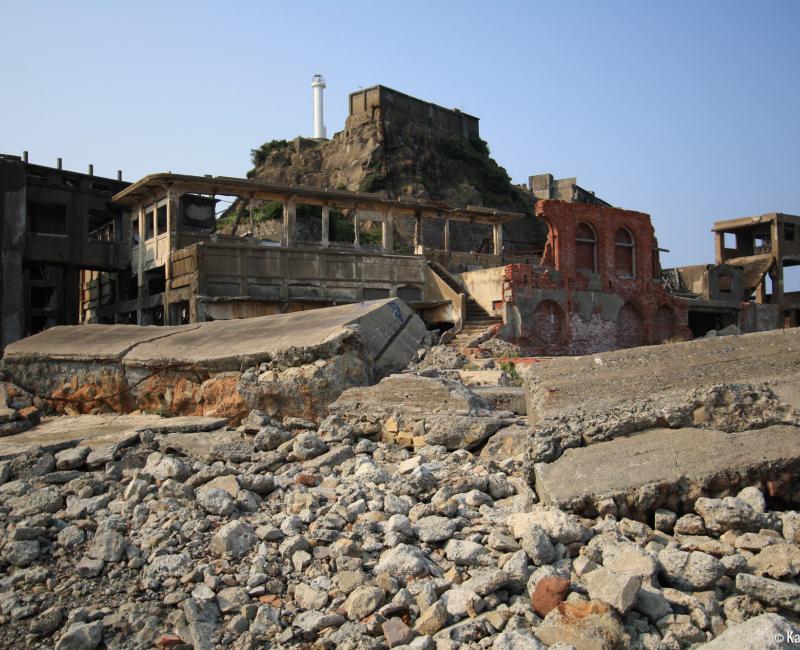
An abrupt withdrawal
After the war, Gunkanjima’s population grew quickly to reach 5,300 inhabitants in 1959. With 84,000 inhabitants per km², it was the highest population density in the world at the time. However, oil became the main source of energy in Japan as well, which impacted on the mine’s activity, that was definitely stopped in the 1970s. The last inhabitants were evacuated in April 1974 .
Hashima was abandoned to the weather’s hardships and especially typhoons 🌀 that hastened the building’s decay. The prefecture deemed the island dangerous and closed it to the public until further notice. After major works funded by Nagasaki City to welcome tourists, the island reopened in April 2009 . Several hundreds of thousands of people visit the island each year, and it even has its own mascot , named Gansho-kun.
For safety reasons, the official guided tour is limited to a southern itinerary, with restricted views. It is also a favorite exploration site for all urbex amateurs, in non-official tours. This kind of activity is naturally prohibited; however it is still possible to have a virtual and safe tour thanks to Google Street .
The incredible setting of Gunkanjima entered the popular culture as the decor for the James Bond series' Skyfall (2012) and a filming location for the movie Attack on Titan (2015).
- Flights and Airports
- Accommodation
- Transportation
- Internet & Phones
- Budget and money
- Japanese Food
- Visit with Kids
- Seasons: spring / summer / autumn / winter
- Weather forecast
- Time in Japan
- Holidays & Festivals
- Natural Disasters
- Customs and Duties
- Works and Closures
- From April 29 to 5 May -- Japanese Golden Week
- May 12 -- Mother's Day in Japan
- June 6 -- Beginning of the rainy season (Tsuyu) in Japan
- June 21 -- Summer starts in Japan
- From July 1 to 31 -- Gion Matsuri Festival in Kyoto with float processions on July 17 and 24
- July 1 -- Season start for climbing Mount Fuji
- Tokyo : Shinjuku , Shibuya , Harajuku , Asakusa , Akihabara , Odaiba , Ikebukuro , Ueno , Roppongi , Chiyoda , Ryogoku ...
- Around Tokyo: Kamakura , Nikko , Hakone , Mount Fuji , Mount Takao , Yokohama ...
- Kansai: Kyoto , Nara , Osaka , Mount Koya , Himeji , Kobe , Kinosaki , Kumano Kodo , Ise ...
- Japanese Alps: Kanazawa , Matsumoto , Takayama , Shirakawa-go , Nakasendo ...
- West: Hiroshima , Miyajima , Shikoku , Onomichi , Naoshima , Izumo , Kurashiki , Matsue ...
- South: Kyushu , Okinawa , Yakushima ...
- North: Hokkaido , Tohoku ...

- Temples and Shrines
- Gardens and Parks
- Hiking and Trekking
- Observation Decks
- Public Baths (Onsen and Sento)
- Festivals (Matsuri)
- Amusement Parks
- Visit on a Budget / Luxury

Keikaku is a travel agency specialist of Japan and providing different kind of services:
- Japan Rail Pass
- English speaking Guides
- Pocket Wi-fi
- Japan Nightlife
- Working in Japan
- Religion and Spirituality
- Arts and History
- Movies / Animated Movies
- Japanese Music
- Studio Ghibli
- Photos / Videos
- Weird Japan
- Translations
- Kana & Kanji
- Japanese Swear Words
- Honorific Suffixes (san, kun, chan...)
- Introducing yourself
- Thank you / Apologize
- Count / Say Your Age
- Say the Date / Tell the Time
- Happy birthday
- Enjoy Your Meal
- Writing your name

Kanas are the much-needed basic characters of written Japanese language. Memorize them at a fast pace with our method.

Ask any kind of question and share your knowledge about Japan in Kanpai’s community space, our Q&A section Kotaete.

Isshoni means "together" in Japanese: share your trip details (dates, places you would like to visit) and find companions to travel in Japan.

Create your Kanpai account to manage your profile and view your participation history (questions, answers).
- A Guide To Exploring Hashima...
A Guide to Exploring Hashima Island

Commonly known as Gunkanjima (literally, “Battleship Island”), Hashima is an abandoned island that once housed more than 5,000 people and served as a labor site during World War II . Located roughly 15km (9mi) off the coast of Nagasaki city, the ruins of Hashima have become something of a tourist destination for adventure travelers and history buffs. We take a look at the fascinating history of this once bustling island and the best ways to see it for yourself.
The industrialization of hashima.
When coal was discovered on Hashima at the beginning in the 19th century, traffic to the island began to increase. From 1887 to 1974, the island served as a seabed coal mining facility; during this time Hashima was constantly inhabited, with the population continuously increasing as more and more undersea coal mines and mine shafts were established. During this time, nearly 16 million tons of coal were extracted from the island’s mines.

In order to accommodate the constant influx of miners and their families, massive concrete walls and buildings were constructed on and around the tiny island. The built-up concrete structures made the island look more like a battleship from afar, thus earning it the nickname “Battleship Island”. From 1930’s through WWII, the island was used as a forced labor site for the production of coal; it is estimated that roughly 1300 workers, primarily Korean and Chinese, died here due do harsh conditions during this time. As petroleum came to replace coal as the nation’s main energy source, the mines began to shut down. Hashima was officially closed as a mining site and cleared of all employees and residents in 1974 where it remained abandoned for over three decades. With most of its structures still intact, the island was reopened as a tourist destination in 2009 and declared a Unesco World Heritage site in 2015.
Getting there
Multiple companies offer ferry tours to the island out of Nagasaki Port (located just a few stops from Nagasaki Station). A standard tour takes around three hours and includes a trip to the island’s three observation decks as well as an hour-long walking tour with a Japanese-speaking guide. Because the abandoned buildings pose a serious safety risk, the tour is fairly restricted and visitors are not permitted to stray from the path. Unless you have a media/press pass, private excursions to the island are illegal. Additionally, due to the harsh waters and weather conditions in the area, passengers may be refused admittance based on physical condition. Newborn babies and pets are of course not allowed. For more information on Hashima tours, check out Gunkanjima Cruise , Yamasa Shipping Co. Ltd. , or the Gunkanjima Concierge Company .

Since you are here, we would like to share our vision for the future of travel - and the direction Culture Trip is moving in.
Culture Trip launched in 2011 with a simple yet passionate mission: to inspire people to go beyond their boundaries and experience what makes a place, its people and its culture special and meaningful — and this is still in our DNA today. We are proud that, for more than a decade, millions like you have trusted our award-winning recommendations by people who deeply understand what makes certain places and communities so special.
Increasingly we believe the world needs more meaningful, real-life connections between curious travellers keen to explore the world in a more responsible way. That is why we have intensively curated a collection of premium small-group trips as an invitation to meet and connect with new, like-minded people for once-in-a-lifetime experiences in three categories: Culture Trips, Rail Trips and Private Trips. Our Trips are suitable for both solo travelers, couples and friends who want to explore the world together.
Culture Trips are deeply immersive 5 to 16 days itineraries, that combine authentic local experiences, exciting activities and 4-5* accommodation to look forward to at the end of each day. Our Rail Trips are our most planet-friendly itineraries that invite you to take the scenic route, relax whilst getting under the skin of a destination. Our Private Trips are fully tailored itineraries, curated by our Travel Experts specifically for you, your friends or your family.
We know that many of you worry about the environmental impact of travel and are looking for ways of expanding horizons in ways that do minimal harm - and may even bring benefits. We are committed to go as far as possible in curating our trips with care for the planet. That is why all of our trips are flightless in destination, fully carbon offset - and we have ambitious plans to be net zero in the very near future.

Guides & Tips
Top tips for travelling in japan.

Tomamu: a secret skiing spot in the heart of Hokkaido

The Best Rail Trips to Book this Year

The Best Solo Trips to Take in Your 30s

How to Experience Off-the-Beaten-Track Japan by Bullet Train

Film & TV
The best japanese movies to watch on the bullet train.

How Much Does a Trip to Japan Cost?

See & Do
The best places to visit with culture trip this autumn.

How modern art revitalised the city of Towada, Japan

Introducing Culture Trip's Rail Trips

The Ultimate Guide to Getting around Japan

Rediscover Japan with its Borders Fully Open
Culture trip spring sale, save up to $1,100 on our unique small-group trips limited spots..

- Post ID: 1358563
- Sponsored? No
- View Payload
Exploring the Ruins Of Hashima Island: A Journey to Gunkanjima (Battleship Island)
Those that have taken the time to tour the Abandoned Hashima Island have found themselves in awe of its forsaken beauty — an awe that is warranted, especially since it has been declared a UNESCO World Heritage Site.
The mysterious abandoned island of Gunkanjima, also known as Hashima Island and Battleship Island, sits 16 km from the mainland of Japan. It’s a place of forgotten history and whispered legends, a secluded remnant of a bygone era.
Exploring the ruins of Hashima Island is an exciting journey that is wildly captivating. Though it is a decaying and lonely place, it can still offer powerful insights into the past and the people who lived here.
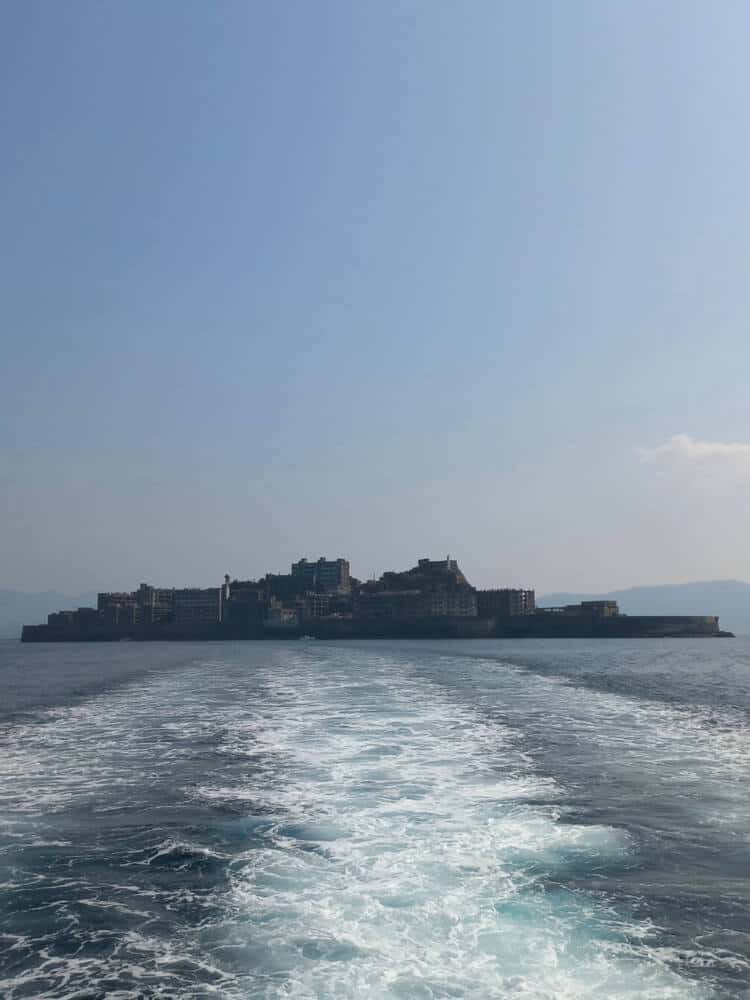
he adventure of discovering Gunkanjima, however, is a story of stark contrasts — one of grand grandeur with a vastness that is overwhelming, of solidarity in a void of silence, and of untouched beauty encased in hauntingly ceaseless ruins.
Page Contents
Visiting Hashima Island
Overview of hashima island and meaning of gunkanjima.

Hashima Island, also known as Gunkanjima (which means ‘Battleship Island’ in Japanese), is an iconic location with a unique and fascinating history.
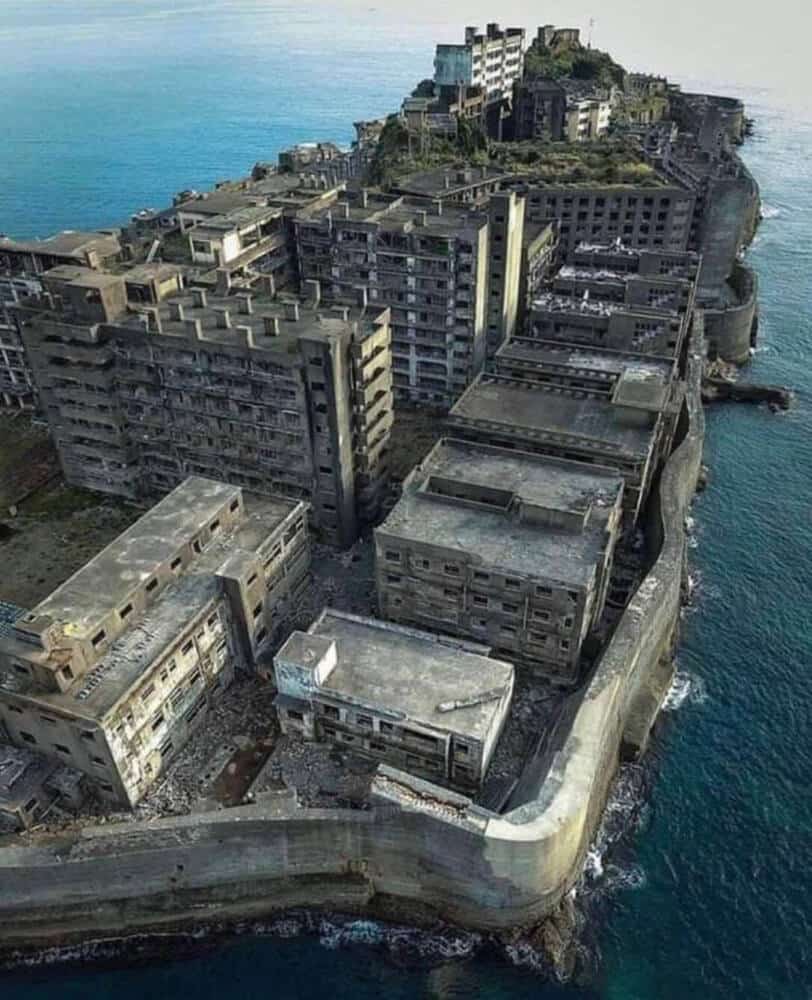
Located in the East China Sea off the coast of Nagasaki of Japan, this World Heritage Site has a very interesting story behind it.
The island, which was formerly owned by a Japanese mining company, had been abandoned for nearly two decades by the mid-20th century; all of its inhabitants left after the coal demand decreased and the operations closed.
Over the years, the empty island has become like a ghost town, giving tourists a glimpse into its mysterious past.
View this post on Instagram A post shared by ̴p̴a̴̴y̴ a̴̴s̴ ̴y̴̴o̴̴u̴ ̴w̴̴i̴̴s̴̴h̴ 🙁 (@pay__as_u_wish)
Today, Hashima Island is known as a symbol of Japan’s industrialization, a living relic that speaks of the rich history shared between Japan and all of its former citizens.
There, one can explore its ruined remains and take in the island’s beauty and charm.
Touring the abandoned island is an unforgettable experience and offers visitors an insight into the era when Japan was in the midst of a rapid modernization process.
It also serves as an important reminder that the past should never be forgotten and that progress must be valued and carefully managed.
- Related: Things To Do In Ishigaki Island
History of Hashima Island
Hashima Island, more commonly known as Gunkanjima (Battleship Island) due to its past and its unique, ship-like shape, is an iconic and mysterious symbol of Japan.
Located in the East China Sea, this World Heritage Site was once home to a bustling coal mine and its population of over 5000 inhabitants.
The island was once a thriving symbol of Japan’s industrialization from the 19th to mid-20th centuries.
In the 1880s, the coal mine opened, and the small, rocky island became the most densely populated area in the world. But by the 1970s the coal reserves dried up and the the island was eventually abandoned in 1974.
It has since been left to the forces of nature, slowly crumbling and being reclaimed by the ocean.
Today, tours are conducted of this forgotten island and its historical ruins.
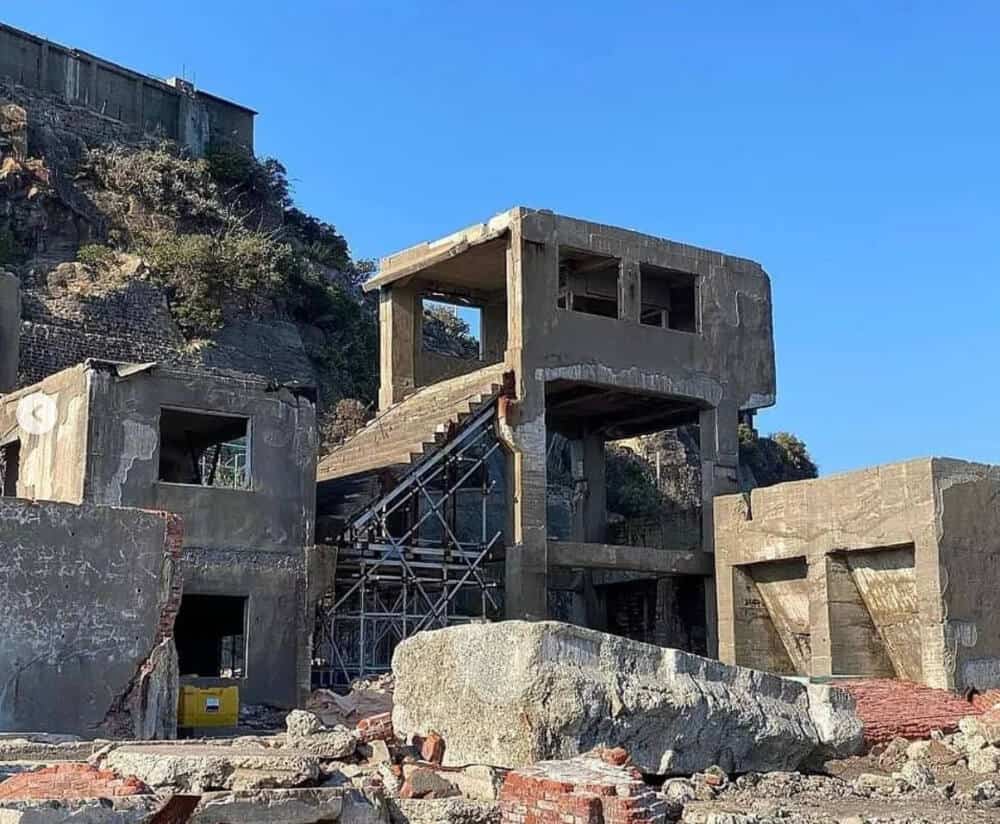
Seeing the dilapidated buildings, concrete storage tanks, swimming pool, and other structures of the past, tourists can experience the haunting industrial landscape and stories of the island’s former inhabitants.
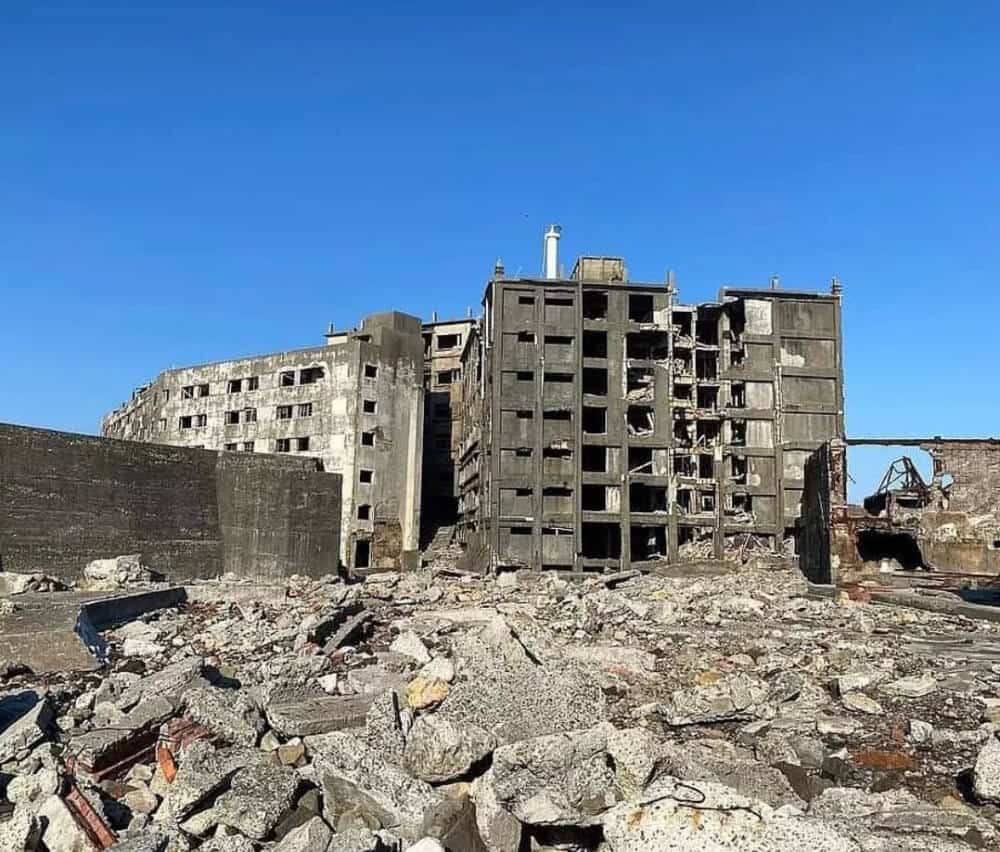
Through these tours, modern-day travelers can gain understanding of the lives of those former miners who worked and lived in Hashima Island, and the legacy of Gunkanjima on Japan’s rich industrial history.
Accessibility and Tourist Experience At Hashimza Island
Touring the ruins of Hashima Island, also known as Gunkanjima or “Battleship Island”, is certainly not for the faint-hearted.
Hashima Island is a remote and isolated location whose crumbling structures have drawn curious visitors for decades.
Accessibility to Hashima Island is highly limited; the only way to reach it is by boat.
Tourists can book a tour at selected harbours in the Nagasaki prefecture to experience its haunting beauty. The tour will usually be accompanied by a licensed guide to ensure a safe, educational and enjoyable experience.

The captivating ruins of Hashima Island have an enchanting, yet ominous presence. For those willing to brave the ocean and explore the island, the experience will be one of awe and curiosity.
Visitors can take in the silent, spectacular views, including the series of tenements and other derelict buildings, all interacting with nature in various shapes and forms.
The captivating experience of Hashima Island is one like no other. With the unique experience of a boat ride to the island, and the eerie bliss of exploring its abandoned structures, visitors get the opportunity to delve into the island’s fascinating history.
The experience makes for a once-in-a-lifetime journey to another world.
Impact of Hashima and Influence on Modern Culture
The eerie ruins of Hashima Island, or Gunkanjima (Battleship Island) are truly a sight to behold. Once a bustling coal mining facility, the island has been abandoned for over 6 decades, with many of its buildings crumbling into the sea.
Today, it serves as a testament to how quickly modern life can change, gaining notoriety as a World Heritage Site.
The abandoned island site has had a big influence on modern culture, from its iconic imagery to its renowned status as an historical landmark. It has been featured in notable films, such as the James Bond movie “Skyfall” and has been photographed many times over by documentary filmmakers.
Even day-to-day travelers are drawn in by the palpable ghostly atmosphere and mystifying architecture, taking touring excursions to witness its desolate beauty firsthand.
The island’s lasting impact goes even further than the general intrigue earned from its visuals. It has a deep-rooted history, once being home to thousands of coal workers, and it serves as an example of how coal powered post-war Japan.
As a cultural reminder of this legacy, the island has become an important symbol of the past, one that continually sends ripples of influence throughout modern culture.
Visiting the ruins of Hashima Island – Gunkanjima, or Battleship Island as it is widely known – is an unforgettable journey through time. Seeing the remains of a once bustling coal-mining town, nestled on an island off of the coast of the Nagasaki prefecture, is a riveting experience that brings history to life.
This journey to Battleship Island illuminates new facets of Japan’s rich history and encourages reflection on the sheer scale of human ambition combined with the harsh realities of industrialization.
As a World Heritage Site, exploring the ruins of Hashima Island will remain an unforgettable experience for many years to come and is one that is truly worth taking.

My writing focuses on the various aspects of Japanese lifestyle, from traditional tea ceremonies and flower arrangement to modern fashion trends and pop culture. Through my articles, I aim to share my passion for Japan and provide readers with a glimpse into the rich and diverse world of Japanese culture.
I believe that the key to understanding Japanese lifestyle is to appreciate the balance between tradition and innovation. While Japan has a rich cultural heritage that dates back centuries, it is also a country that is constantly evolving and embracing new ideas and technologies.
Whether you’re interested in learning about the latest fashion trends in Tokyo, or want to explore the ancient art of calligraphy, my writing will take you on a journey through the many facets of Japanese lifestyle. So join me as we explore the beauty and complexity of this fascinating culture together!
What do you think?

Is Kyoto Botanical Garden Worth Visiting?

100 Basic Japanese Words To Use To Have Easy Conversations
© 2024 by Novatise Pte Ltd
Username or Email Address
Remember Me
Forgot password?
Enter your account data and we will send you a link to reset your password.
Your password reset link appears to be invalid or expired.
Privacy policy, add to collection.
Public collection title
Private collection title
No Collections
Here you'll find all collections you've created before.
Ship viral Japanese Products to your doorstep! Dismiss
Privacy Policy - Terms and Conditions

How To Visit Hashima (Gunkanjima or Battleship Island) Nagasaki
Some posts on this site contain affiliate links, meaning if you book or buy something through one of these links, I may earn a small commission. Read the full disclosure policy here .
Gunkanjima – Hashima OR Battleship Island, Nagasaki
If you find yourself in Nagasaki in Japan, Gunkanjima (or Hashima Island) is a must visit. A remnant from coal mining in the 60's the island shot to fame when it was used in the Bond movie Skyfall. It is only a half day tour from the centre of Nagasaki to the island and back and is really worth it. If you are wondering if you should go, read on for all the info about the island, how to do a tour and what you can expect to see.
Table of Contents
Why does Battleship Island have 3 names?
When I was looking to visit the island it seemed to have 3 different names. Hashima Island, Gunkanjima Island and of course Battleship Island. The battleship part was easy enough, but my Japanese was bad enough that I couldn't seem to work out why it had 2 other Japanese names. I'm embarrased to say that I was well into Korea before I remembered to research it.
The island is called Hashima Island. Gunkanjima is the Japanese word for Battleship – so really its got is actual name (Hashima) and then the reference to its shape in both English and Japanese. Of course then I went down the rabbit hole of “what if I speak German? Is it then Hashima, Gunkanjima, Battleship or Schlachtschiff island?” Sometimes my brain just works weird. Anyway, back to the abandonded battleship island off Nagasaki!
As I moved south through Japan I started to see much better weather and the beautiful days I got in Nagasaki was clearly the start of spring in Japan. It was still only March but the advice that a colleague gave me about working my way south was right on the money it seems.
Nagasaki is a bustling port city in the south west of Japan. Despite the fact that it is built around trade it's a lovely city and has some really cool things to see.
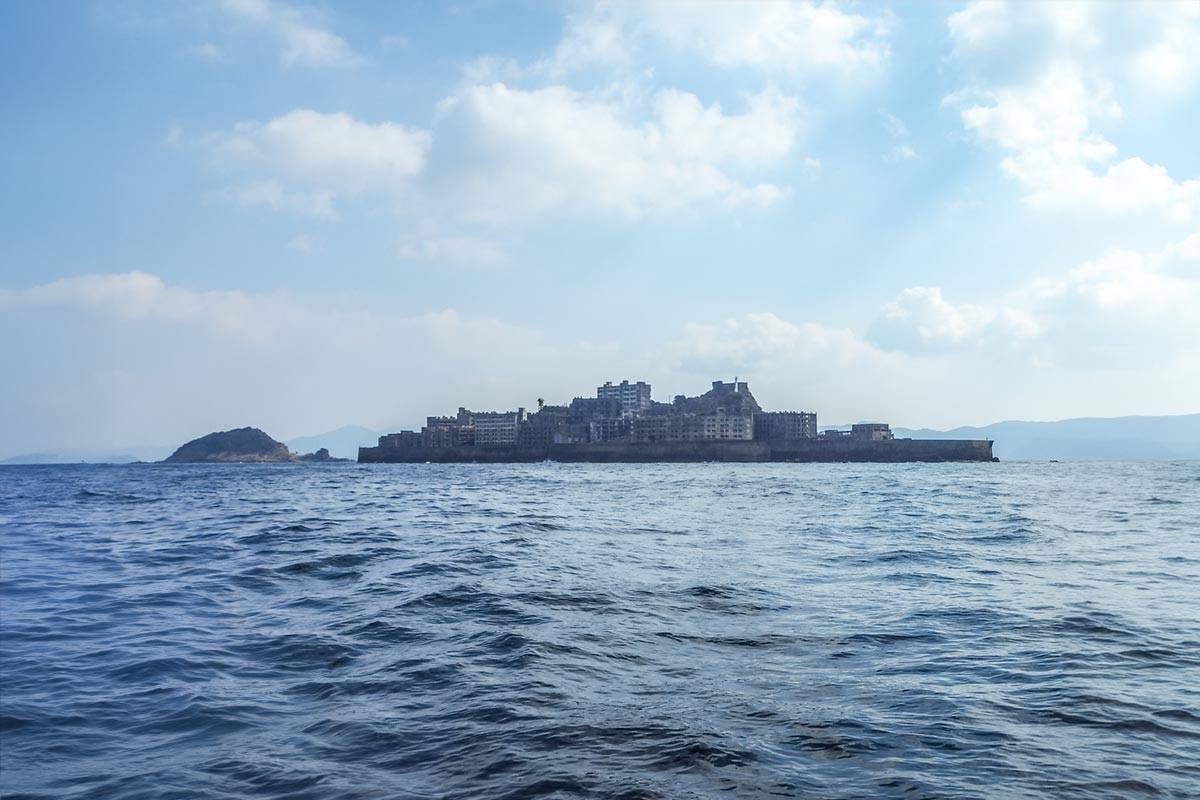
How did the abandoned Hashima Island get to be a tourist destination?
Have you seen Skyfall, the Bond movie where Javier Bartem is the villain? His mysterious base is on an abandonded island that is falling down and in horrific disrepair. They filmed that on Hashima Island. It was Bardem's character Raoul Silva's base.
Hashima is referred to as Gunkanjima or Battleship Island because from the sea the structures give it a perfect battleship silhouette. It's quite uncanny. I'm sure that before Skyfall it was probably a tourist attraction already, however the movie can't have done it any harm that's for sure.
Gunkanjima – Hashima Island History
Coal mining on hashima island.
The island was always there, however it was just a rocky outcrop until coal was discovered beneath the ocean in the area. After being purchased by Mitsubishi in the late 1800s, the island was built out to service the undersea coal pocket and the workers that mined it. The land that was reclaimed trippled the island in size and it ended up around 16 acres in size.
While the mine was operational as early as 1887, it wasn't until 1916 that Mitsubishi built a 7 story apartment block to house the miners. Over the years more and more facilities were added with Battleship Island ending up a thriving community of workers and their families.
A sea wall was built to protect from typhoons (hurricanes or cyclones), and over the next 50 years facilities built on the island included:
- more apartment buildings
- a school and kindergarten,
- a town hall and post office,
- a community center and cinema,
- a public bath house and a swimming pool.
Shops, gardens and public spaces were added to complete Hashima Island as an attractive option for many unskilled workers. Decent pay and a good family life meant that at one point the island reached a population of just over 5200 people in the late 1950s. The population density was nine times higher than Tokyo at the time.
Battleship Islands Disturbing Past
During the second world war the island saw Korean civilians and Chinese prisoners of war forced to work the mine under terrible conditons. It's estimated that over 1000 of these workers died during this period due to exhaustion, extemely unsafe working conditions and malnutrition.
While there was no information or memorial to these POW's at the time I visited, I have since heard that there is a plan to construct one.
The demise of Gunkanjima Island as a working coal mine
While the coal mined was of decent quality the pit eventually reached almost a kilometre below the surface meaning that the cost to pull the coal out overrode the profit from the ore. The mine was closed in 1974, everyone was removed from the island and it just started to decay.
Even though the island was no longer an operating coal mine, Mitsubishi retained its ownership until 2002 when they transferred it to Takashima which was later included in the greater Nagasaki area.
33 years later in 2009 boat tours were established to visit the island and almost 80% of tourists to Nagasaki now visit this abandoned ghost town.
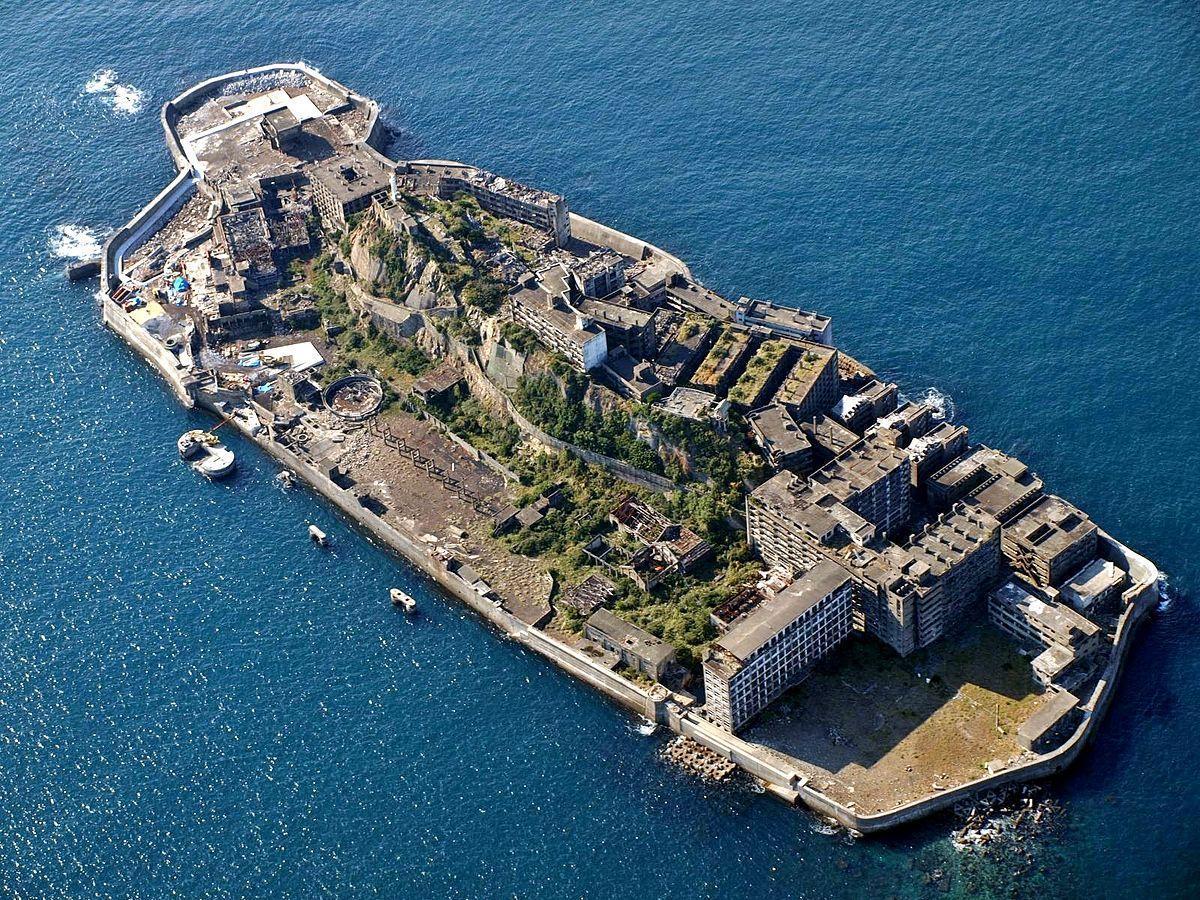
Battleship Island – Hashima Island Tour
Due to the total visitor ban the island lay abandoned and virtually untouched for decades. Local fisherman were known to tie their small boats up alongside and sleep on the island overnight, however this was the only real human interaction with the island for years.
While the tours started as early as 2009, Skyfall exposed the island to a global market and unregulated visits were clamped down on and paths were cleared for the visitors to safely visit the island.
Things to know before you visit Hashima (Gunkanjima) Island
If you would like to visit Battleship Island there are a few things to be aware of before you go.
You can't visit the island by yourself
Can you go to Hashima Island by yourself. No sorry you can't. Likewise have you been wondering how to get to Hashima Island? Again – you can't just hire a local boat and go out to the island. It is closed to the public unless you are on a registered operator.
While seeing this abandoned location is very much worth it, you do have to go on a tour. The Japanese government has mandated that solo visitors are not allowed onto the island and unless you have arranged a specific private visit, you should not try to do so.
I'm not sure how you would even go about that, but while the island is amazing to see it is still full of derelict buildings and rubble and is wildly unsafe if you don't know where to walk. Stick with the tours and don't risk it yourself.
The sea around Nagasaki can be rough
Nagasaki is a port town which means access to the port is via a natural deep water harbour. Being on the western coast of Japan the ocean around Nagasaki can get very rough and its not unusual for tours to be cancelled due to rough weather. If you have a few days I would recommend booking Battleship Island on the first day so you have options should the weather come up and the company cancels.
There is also the possibility that you may not be able to get off on the island if the weather worsens suddenly. The day prior to my trip the company got out there OK and the swell wasn't due to get any bigger until late afternoon, however it started to get pretty rugged pretty early so they turned around and went back to Nagasaki.
The tour companies don't guarantee that you can get off on the island so please don't get angry with them if they decide that its not safe to dock.
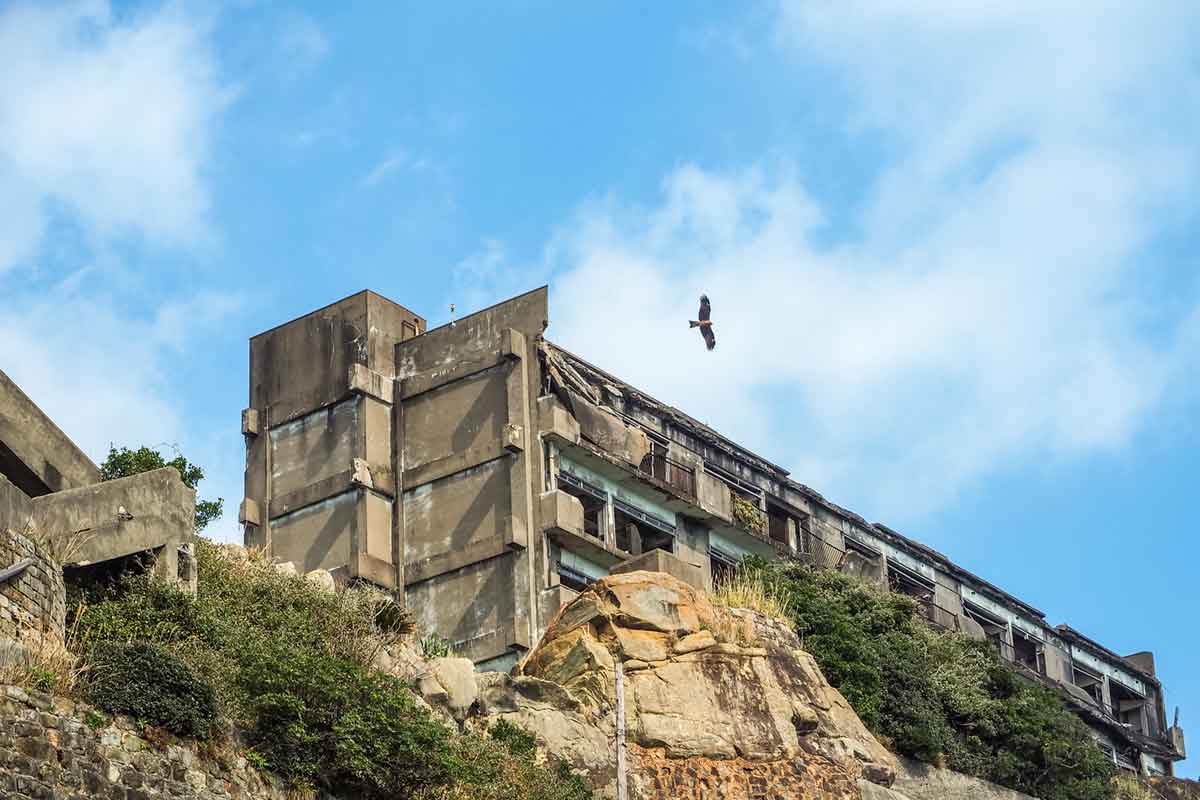
You have to be physically able to do the tour
Neither the boats or the island are wheelchair accessible unfortunately. You are walking over cleared paths, however you do have to be able to climb a few stairs and getting off the boat and back onto the boat isn't possible with a wheelchair.
Prams are also not allowed however I've heard that different companies have different policies for this. The company I went with did allow a Japanese couple with a toddler on board, however they did have to leave the pram at the tour office. They were very strict about that.
There are also no animals allowed which includes assitance animals. That does seem strict but honestly I'm not sure how you would navigate the island even with a seeing eye dog. If you had someone with you I'm sure you would be fine, however I would check first that they will allow you to go.
You will have to sign a waiver
The tour company will ask you to sign a waiver that includes what you can and cannot do. Its pretty much common sense, however once we were on the island I saw the reason for it. People just don't listen! Immediately we were off the boat and some young couple climbed under a railing onto some very unstable rocks to take what I can only assume was a photo for Instagram.
OMG people are stupid!
A lady next to me that spoke Japanese told me that the guide told them that if they stepped one more foot wrong, they would be escorted back to the boat and they would have to wait there for the rest of the group.
Your time on Hashima Island is only an hour long
The total tour takes about 3 hours. An hour out to the island, an hour on the island and the trip back. The trip back in our case was a little longer because they idle offshore so you can get the “battleship island” photo.
Even though it was a pretty cool day, getting a spot to take a decent photo of the battleship silhouette was a bit of a challenge. Lets just say that me being 6 feet tall enabled me to get at least one. A good example of some people thinking it's OK for them to monopolise the view and get 45 photo's but won't let you through for even one.
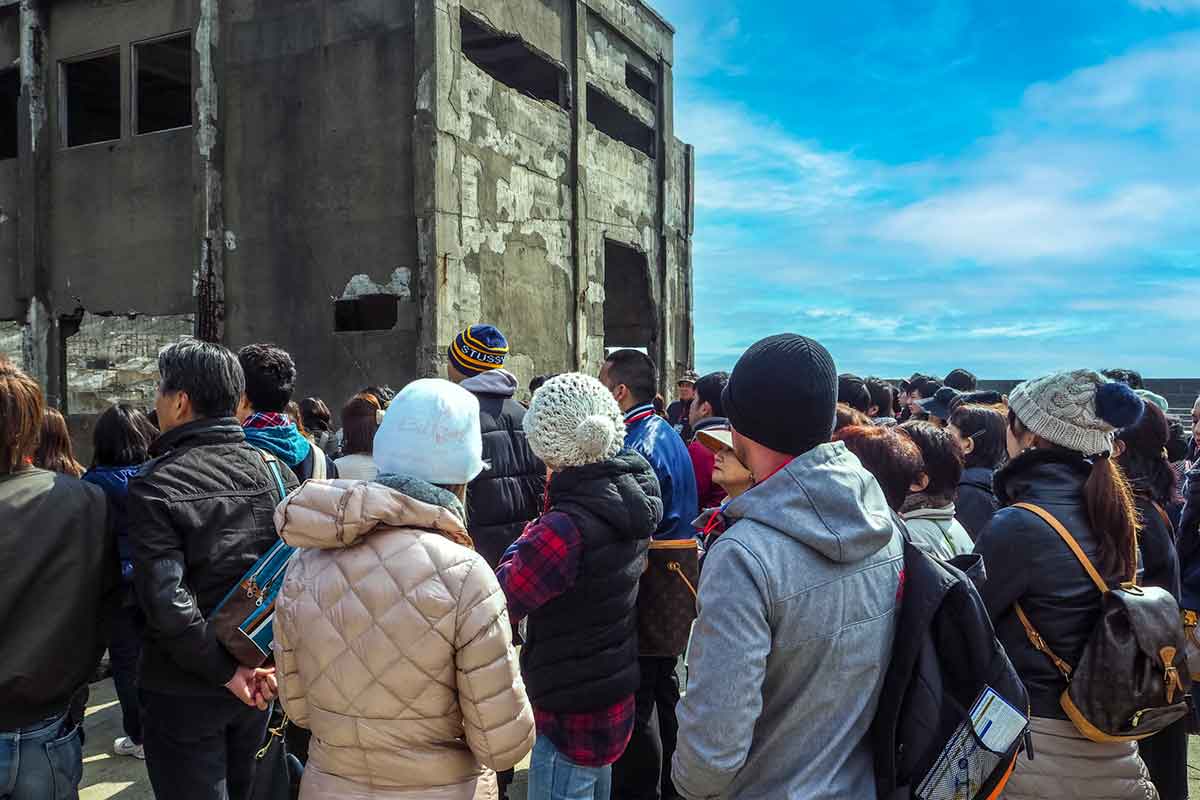
Tour Companies for Gunkanjima – Battleship Island Tour
There are morning and afternoon boat tours to Gunkanjima Island, but I would recommend the afternoon one. The morning is often a lot of group tours I was told and even though there were a lot of people on my tour, no-one was walking holding flags at least!
The exception to this would be if the weather is rough. Morning is always a better option for windy days and it almost always gets worse as the day goes on. If you might get the slightest bit seasick, go in the morning.
I booked online through Viator (its easy, its online and you have comeback if something happens) and it was great. It was just easier for me to book online and know I had secured a spot in advance.
Sadly Daniel Craig never showed, but I did enjoy the boat trip to the island very much.
NB: Make sure you check the websites for arrival times for these tours below. Often you do have to be there a full half hour before the tour starts and the check in location isn't always the dock. So just check that before you book.
Your Options for a Gunkanjima Tour
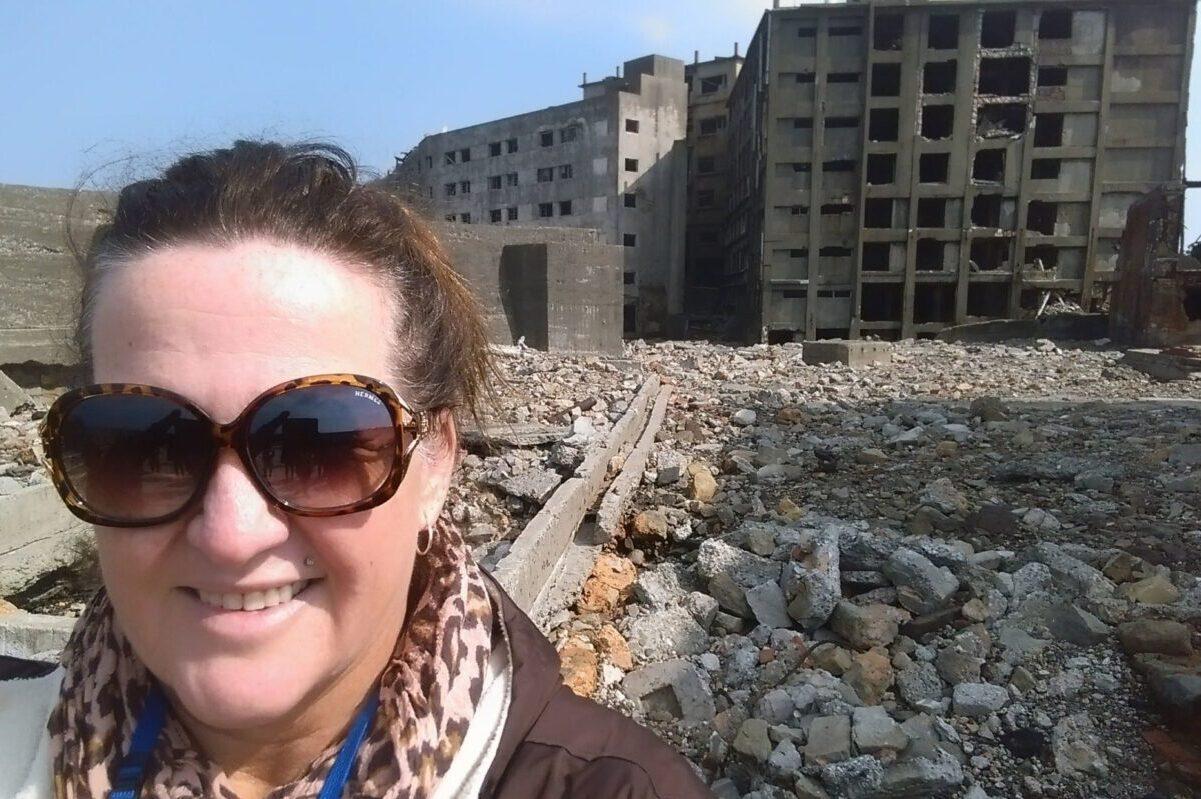
Conclusion: Gunkanjima, Hashima or Battleship Island (you choose!)
I really enjoyed the trip out to and the hour I spent on the island. I was really interesting to learn the history of the island and how many people had actually lived there. I must admit I found it because of the Bond movie but I was glad I had. It was a great morning out and we were blessed with decent sea conditions as well.
Day Tours In Nagasaki
If you would like to do something else while in Nagasaki, these tours will help you to see everything on offer in this great Japanese city.
Other Japan Posts You Might Like
Miyajima Island, the famous floating Torii Gate & Mount Misen Hike Visit Clover Gardens and Dutch Slope

Meet Jenny, a passionate Australian travel blogger who has explored 103 countries to date. With over 30 years of travel experience, Jenny has a wealth of knowledge to share with her readers about the cultures, landscapes, and people she has encountered on her journeys. She's always battling unfashionably frizzy hair and you will never catch Jenny in anything but comfortable shoes. Learn more about Jenny and her travels.
Share With Your Friends
A guide to visiting deadvlei sossusvlei namibia, tips to travel safely as a female, leave a comment cancel reply.
Save my name, email, and website in this browser for the next time I comment.

IMAGES
VIDEO
COMMENTS
Once home to over 5000 people, it's now an abandoned ruin and visitors are finally allowed to explore. However, as coal power gave way to gasoline, coal prices fell, and many mines, including Hashima, were permanently closed. By 1975 the island was completely evacuated.
Top ways to experience Hashima Island and nearby attractions. Visit Gunkanjima Island (Battleship Island) in Nagasaki. 11. Historical Tours. from. $58.85. per adult. Nagasaki Half-Day Private Tour with Government-Licensed Guide. 18.
Courses. Important points. Cancel charge. In April, 2009 the ban on landing on Hashima (commonly called Gunkanjima) was lifted. The trip will give you a firsthand experience of this once prosperous deserted island. Why not feel the unique history of Nagasaki through a Gunkanjima tour, visiting the site of Kitakeii Mine, Glover Garden and other ...
Prices don't differ all that much. For a "cruising and landing" tour the price is about ¥4,000 per person including the ¥300 landing fee levied by Nagasaki City. Guided tours take approximately 3 hours, including a 1 hour tour of the island itself. All tour companies offer a morning (9-10am) and afternoon (1-3pm) cruise.
Gunkanjima (軍艦島) is a small island located about 20 kilometers from Nagasaki Port. Until 1974, the island served as a coal mine, and more than 5000 residents called the 480 meter long, 150 meter wide island home, resulting in the highest population density in history recorded worldwide. To accommodate so many people in such a small area ...
These tours are carefully managed to ensure safety and preserve the site's integrity. English-language tours are also available on Hashima Island (Gunkanjima). Important Notes: Tour Requirement: Access to Gunkanjima is only possible through the official landing tours. Self-guided visits are not permitted due to safety concerns and the ...
At its peak, the small island stretching just 160 meters east to west and 480 meters north to south, was home to over 5,000 people. When the coal ran out, the workers left, and the entire island became a ghost town. While the island's official name is Hashima, its silhouette resembles a battleship, earning it the nickname Gunkanjima ...
Top ways to experience Hashima Island and nearby attractions. Visit Gunkanjima Island (Battleship Island) in Nagasaki. 11. Historical Tours. from. S$80.57. per adult. Nagasaki Half-Day Private Tour with Government-Licensed Guide. 18.
Hashima, a decaying bubble. Hashima, often referred to as Gunkanjima, or Battleship Island, due to its boat-like profile, is a UNESCO World Heritage Site located 15km from Nagasaki 's city center. Coal mining kicked off here around 1887 and continued for nearly a century until 1974. At its peak, Hashima's population was over 5,000 people ...
Hashima Island Guide. posted by John Spacey, March 03, 2015. Hashima is an island near Nagasaki that was once densely populated but was suddenly abandoned in 1974. Today it's a rare example of how the world would look if humans were to disappear.The island was a coal mine established in 1887. Deep mines extend below the ocean around the island.
Half-day Tours in Nagasaki: Check out 44 reviews and photos of Viator's Visit Gunkanjima Island ... Hashima Island. 3 hours • Admission Ticket Included. 2. Gunkanjima Digital Museum. ... Price varies by group size. Private Sightseeing Tours. Nagasaki, Nagasaki Prefecture ...
The tour would be in English tour for a total price of 4500JPY. It was a little more than the tour you can book online (4300 JPY), but it was great being able to book last minute. ... If you're not as lucky, the Hashima Island tours offer free refunds if the weather is so bad that they can't even leave the Nagasaki ferry port.
A former coal mine in the middle of the sea. Lying nine miles from mainland Nagasaki , Hashima—or Gunkanjima (Battleship Island) as it is more commonly known—is the most famous of Nagasaki's 505 uninhabited islands. Given the nickname for its battleship-like silhouette, the eerie island and its former coal mine are one of Japan's most ...
Tour companies require guests sign safety waivers and wear hard hats while on the island. Tour Prices Ferry tours from Nagasaki range from ¥3,600 to ¥4,200 for adults, with discounts available for groups of 15 members or more.
Hashima (Gunkanjima) is a small island 19 kilometers from Nagasaki where in 1890 The Mitsubushi Corporation began a full-scale seabed coal mining operation. In 1916 Japan's first reinforced concrete high-rise apartment building was constructed to house the growing population. Surrounded by a sea wall, the island measures only 480 meters by 160 ...
Visit Gunkanjima Island (Battleship Island) in Nagasaki. By Beauty of Japan. 11 reviews. See all photos. About. from. $59.10. per adult. Lowest price guarantee Free cancellation.
Itinerary. 12pm: Visit the Gunkanjima Digital Museum to see the island in busier times. 1.20pm: Boarding for your boat to Gunkanjima. 1.40pm (approx): Arrive on Hashima Island for an hour's guided tour. 4.20pm (approx): Return to Gunkanjima Concierge Office. Written by: JC Team.
Top ways to experience Hashima Island and nearby attractions. Visit Gunkanjima Island (Battleship Island) in Nagasaki. 8. Audio Guides. from. AU$96.68. per adult. Nagasaki Half-Day Private Tour with Government-Licensed Guide. 11.
The Ghost Island, now mainly called Gunkanjima (literally "Battleship island" due to its warship appearance), is located in Nagasaki prefecture, about twenty kilometers to the south-west of the eponymous city. Hashima was initially a desert island until an important coal deposit was discovered in 1810, and the powerful Mitsubishi group settled ...
Dave Afshar 12 April 2021. Commonly known as Gunkanjima (literally, "Battleship Island"), Hashima is an abandoned island that once housed more than 5,000 people and served as a labor site during World War II. Located roughly 15km (9mi) off the coast of Nagasaki city, the ruins of Hashima have become something of a tourist destination for ...
History of Hashima Island. Hashima Island, more commonly known as Gunkanjima (Battleship Island) due to its past and its unique, ship-like shape, is an iconic and mysterious symbol of Japan. Located in the East China Sea, this World Heritage Site was once home to a bustling coal mine and its population of over 5000 inhabitants.
Gunkanjima - Hashima OR Battleship Island, Nagasaki. If you find yourself in Nagasaki in Japan, Gunkanjima (or Hashima Island) is a must visit. A remnant from coal mining in the 60's the island shot to fame when it was used in the Bond movie Skyfall. It is only a half day tour from the centre of Nagasaki to the island and back and is really ...
Hashima Island was just recently designated a UNESCO World Heritage Site, so as of Fall of 2015, the tours are really crowded with Japanese tourists so book well ahead. The Gunkanjima Cruise company caters purely to Japanese speakers so I don't recommend it for those who don't speak the language unless (like me) you couldn't book with ...